
This section deals with headgear, uniforms and equipage associated with the China Marines. Also included in this section are EGAs, medals and other things these men would have worn.
Headgear
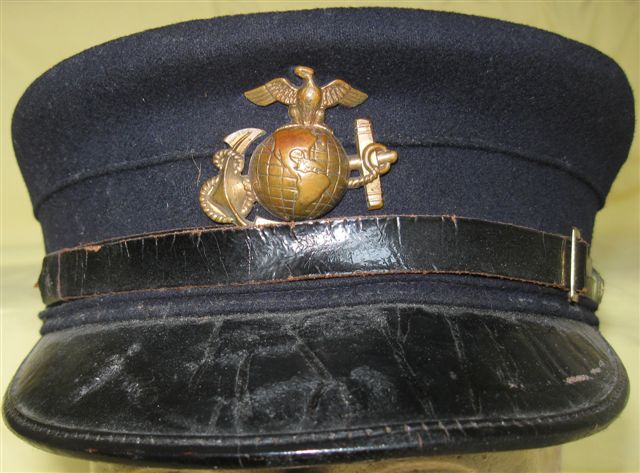
1897 Cap. Based on the 1895 Army forge cap, this model was worn during the Spanish-American War and the Boxer Rebellion.The example shown here is depot made, with Horstmann of Philadelphia side buttons. The Eagle Globe and Anchor (EGA) shown, has been "customized" by the Marine by clipping the eagle's wings. Such customization was against regulations, but was common up to the start of WWI. The EGA also matches b-162 in Frederick Briuer's book United States Marine Corps Emblems, Vol I. Briuer notes "this type is seldom enountered....suggesting low manufacture before the 1904 bronze emblems."
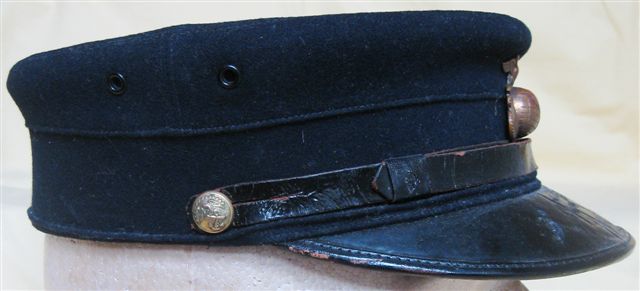
Profile of the 1897 cap.
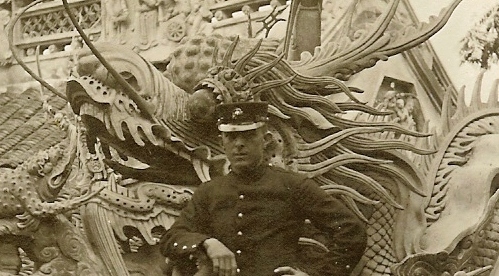
Model 1897 hat being worn by a Marine off the USS Baltimore.
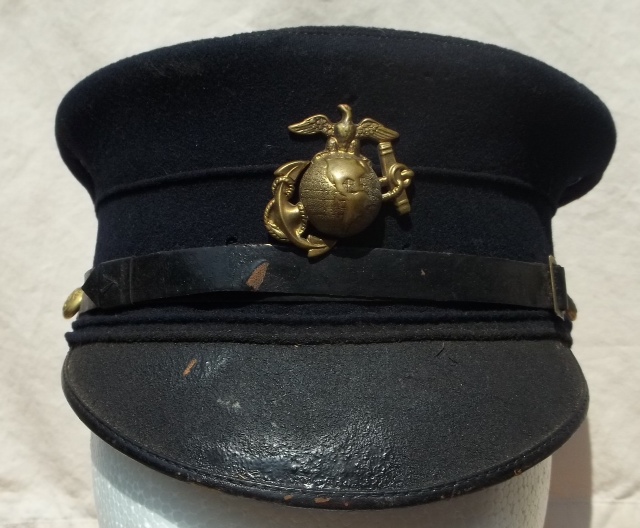
1904 Pattern Cap. Courtesy the Tim Brig Collection by William Horstmann and Sons of Philadelphia. This cap appears to have a standard Horstman supplied EGA.
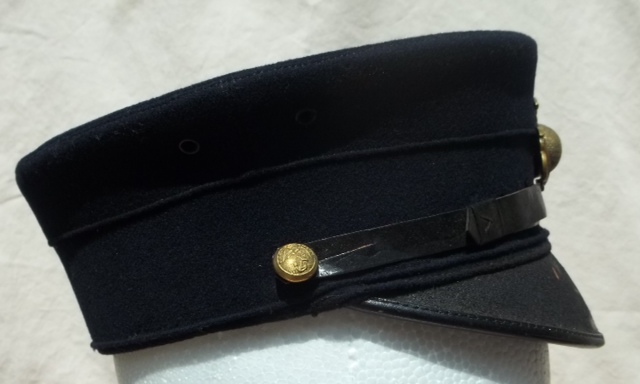
Profile view of the 1904 Pattern Cap. Courtesy of the Tim Brig Collection.
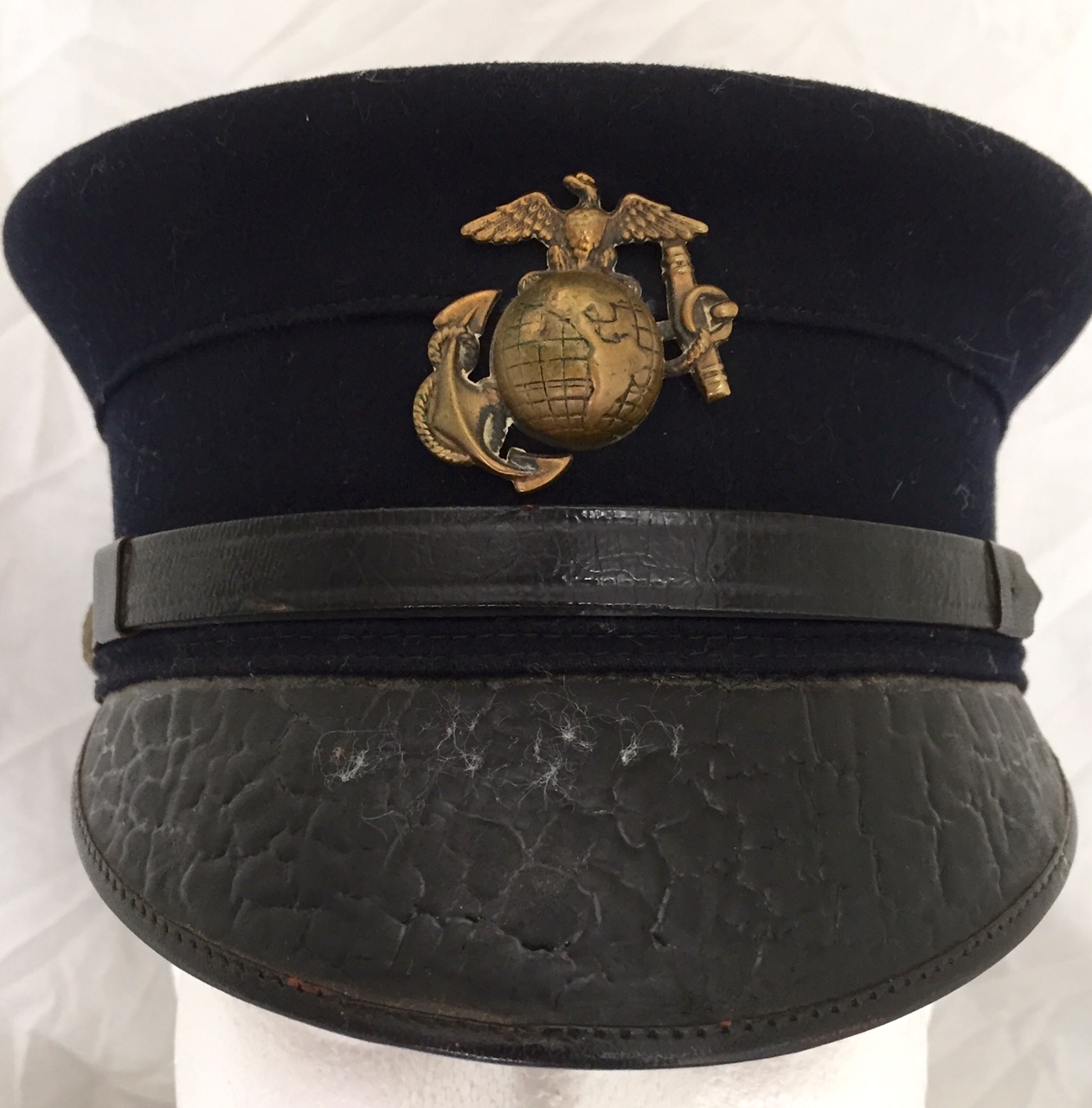
Another Horstmann and Sons contract 1904 Pattern Cap. The EGA on this cap matches Briuer's b-163 "deep feathers type" with its "extremely well struck feathers. The grazing on the cap's bill is from improper storage in high heat condistions.
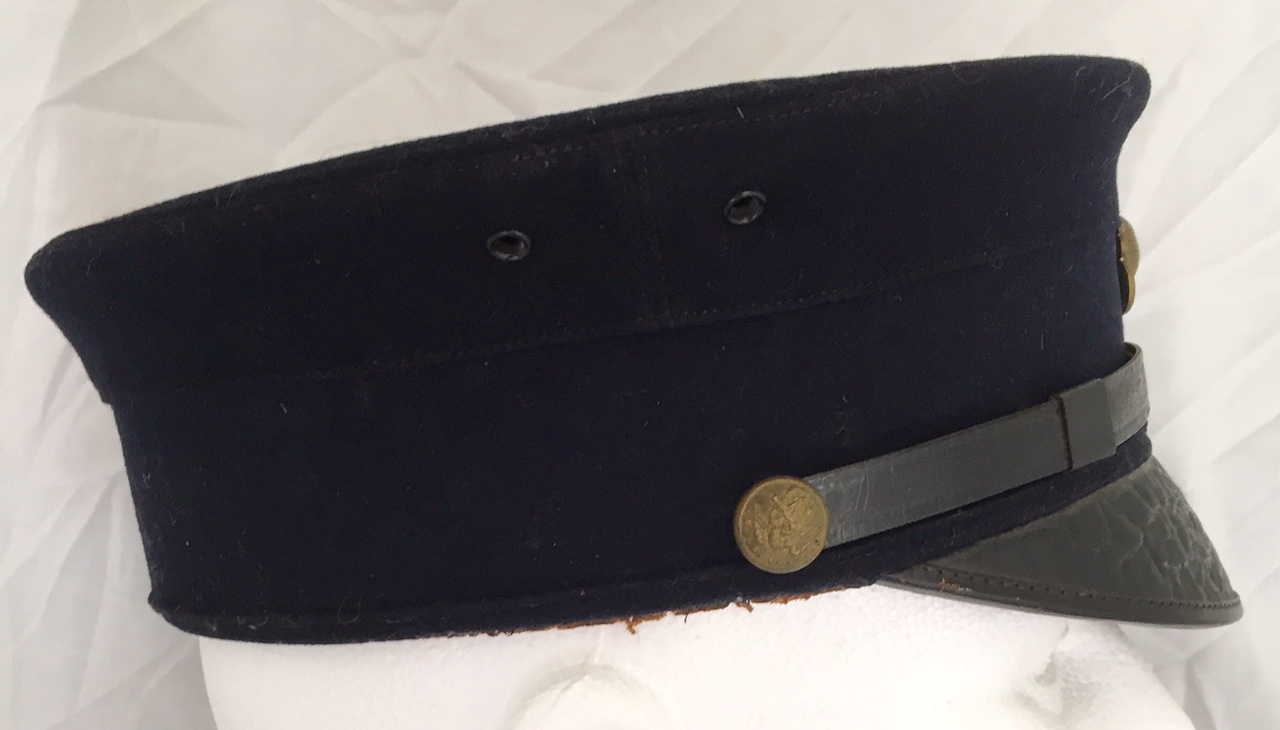
Profile view of the Horstman Contract Cap.

The 1904 Pattern Cap.
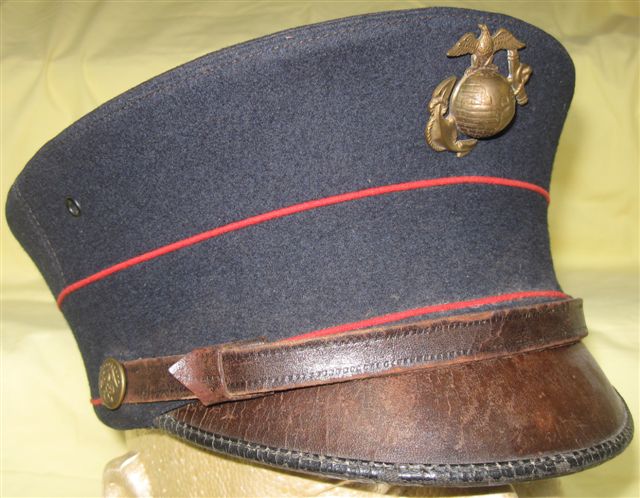
The 1917 pattern dress cap. Known as a "bell crown", the two differences between this cap and the 1904 pattern, is the 1917 now has two scarlet 1/8 inch wide welts bordering the middle and lower portions of the cap's band. Also unlike the 1904 cap, the EGA on the 1912 cap is mounted above the cap's center. In this case, a 1916 pattern EGA is shown on this cap.
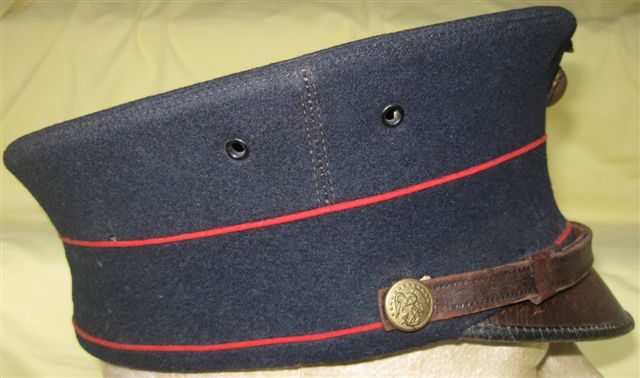
Profile of the 1917 pattern Bell Crown.
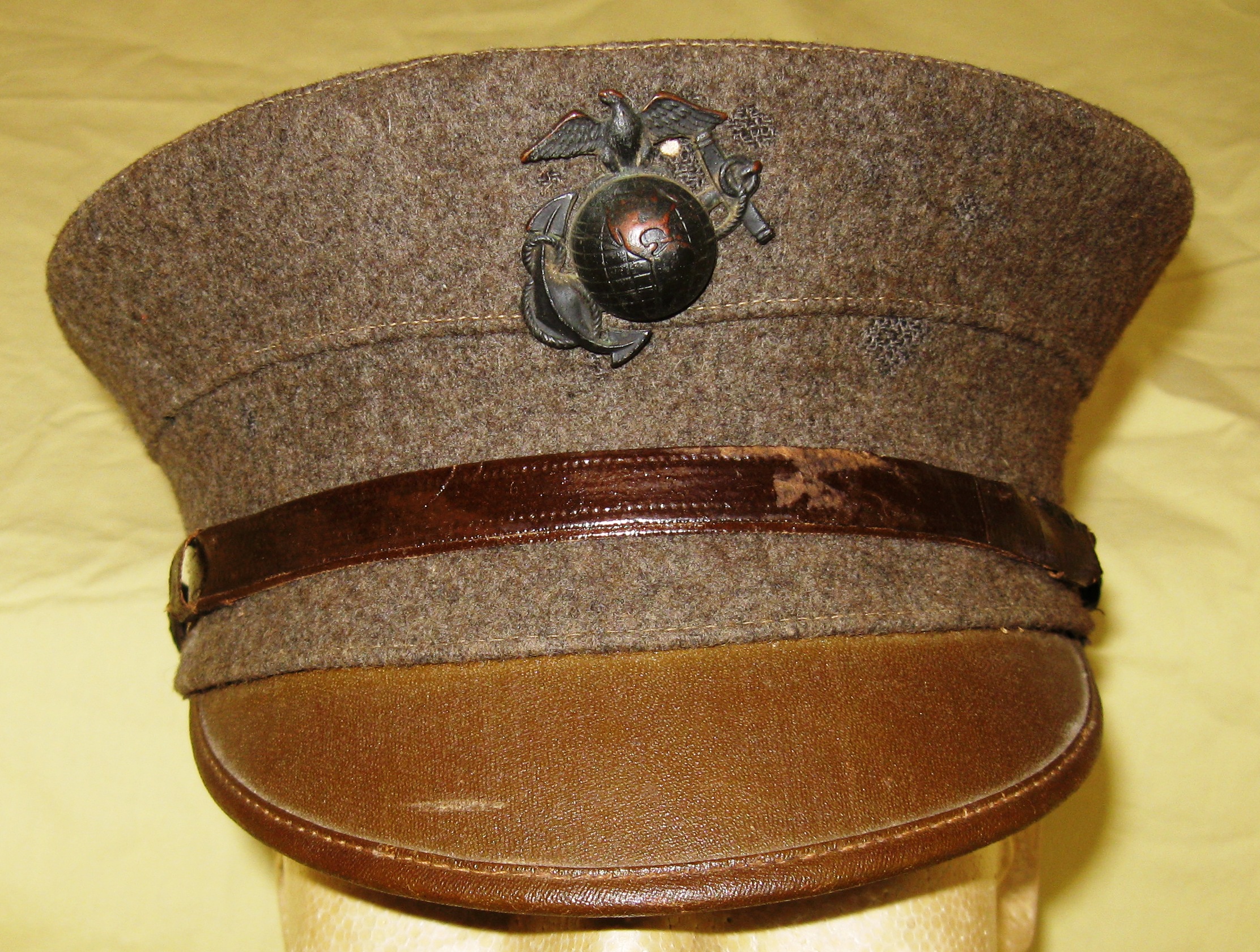
1912 Winter Service Cap. This cap could also be worn with a Khaki slip-on cover. A 1916 pattern EGA is shown on this cap.
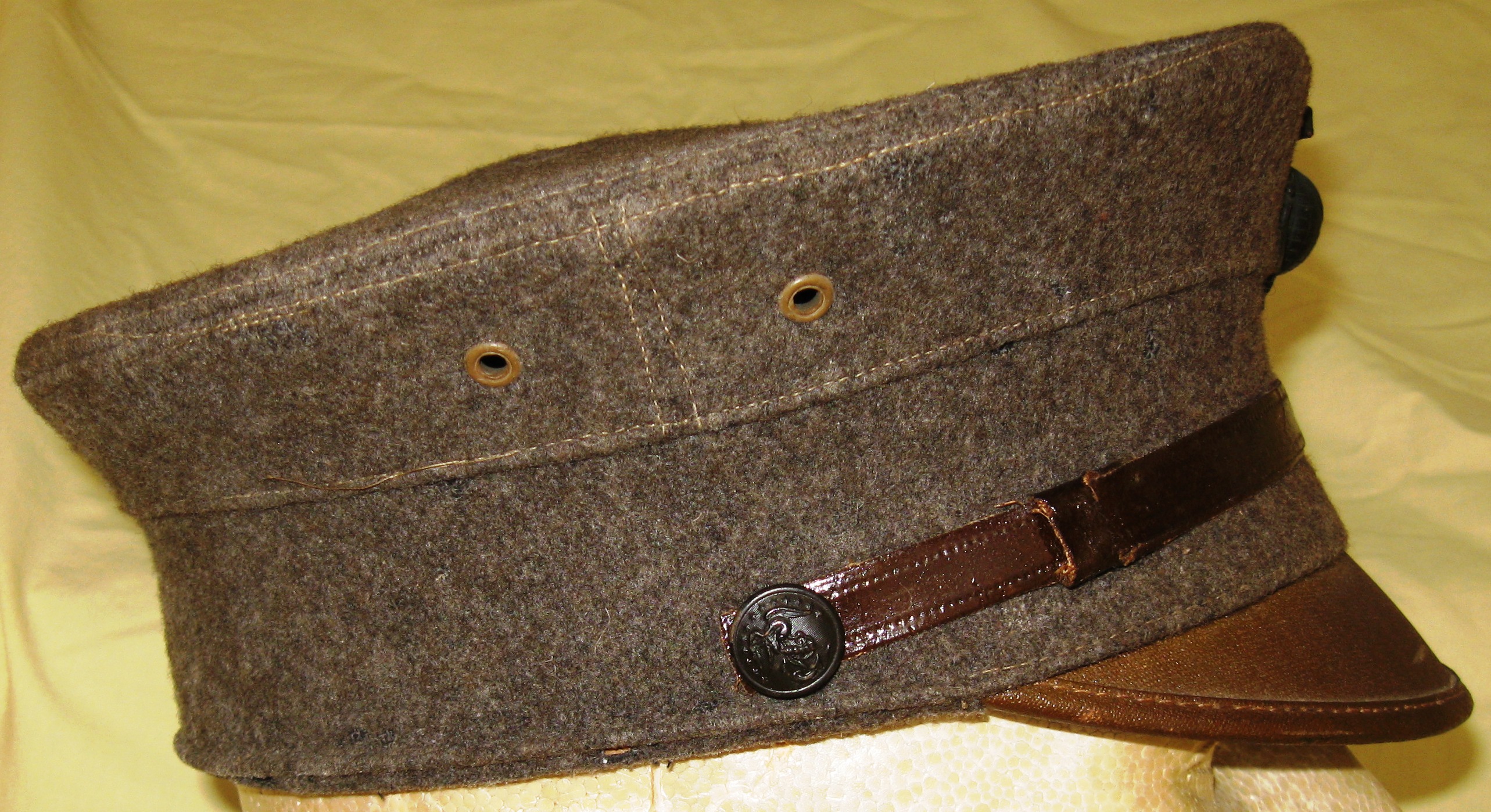
1912 Winter Service Cap in Profile.
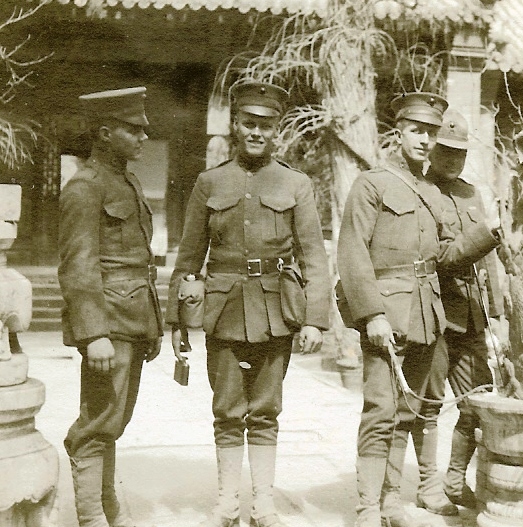
The 1912 Pattern Service Cap as worn by Bandsmen outside of Peking.
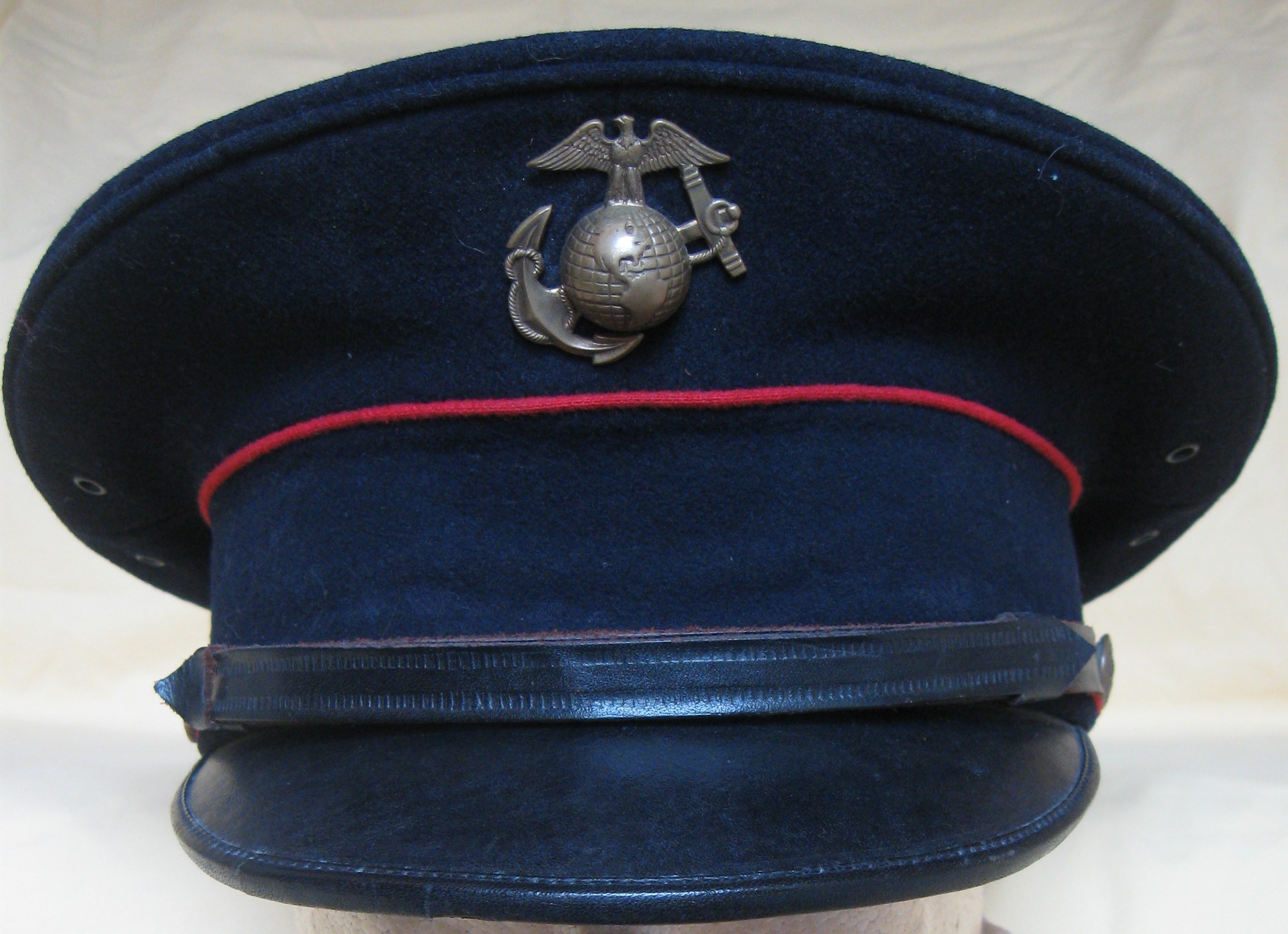
The 1922 Pattern Cap. This cap superseded the 1912 pattern bell crown, although it took about another year before this cap was commonly seen on China Marines. The EGA shown on the cap is a 1930 dress pattern. Although the EGA appears silver in this picture, it has a deep bronze color.
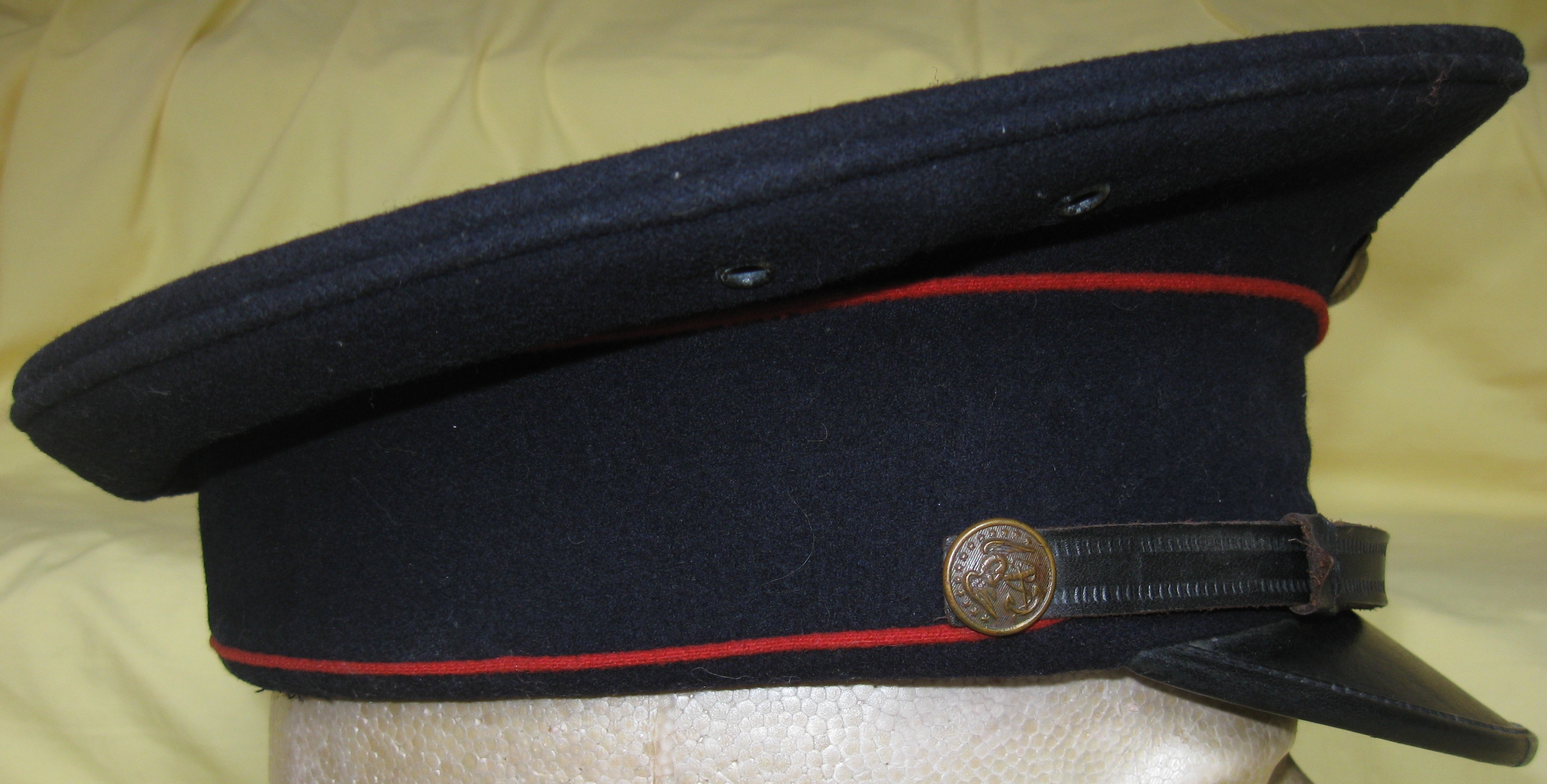
Profile of the 1922 Pattern Cap
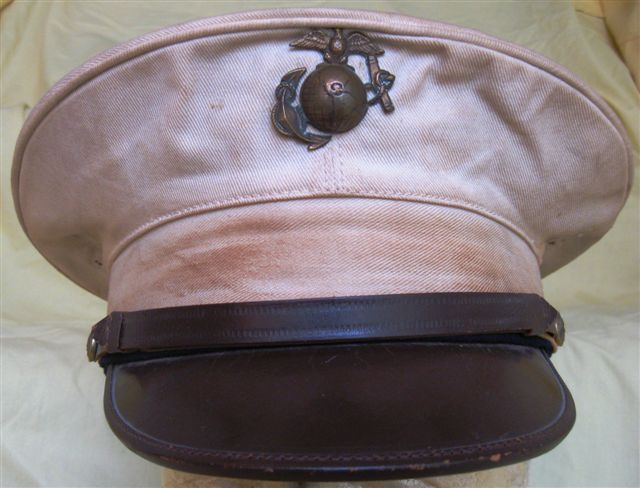
1922 Pattern Service Cap with White Cover. This cap was built on a wicker and metal frame that allowed the Marine to replace the existing cover with one in blue or khaki. This particular cap has a 1925 contract stamp on the sweatband. The EGA is a 1916 pattern, as the original owner was a WWI Vet. It was not uncommon for Marines to continue wearing an outdated EGA on their caps as a way of marking when they came into the Marine Corps.
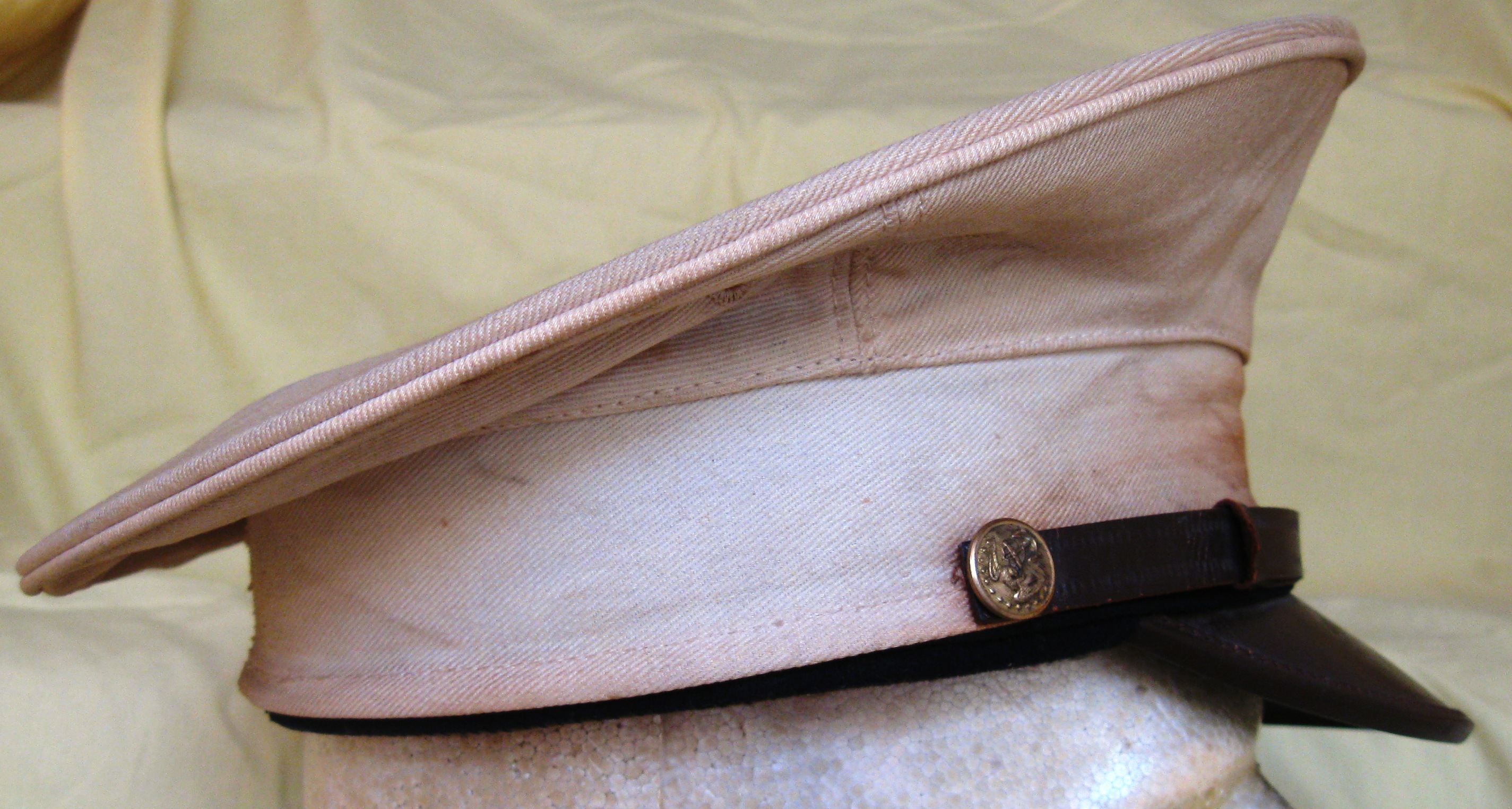
Profile of the 1922 Pattern Service Cap with White Cover

1922 Pattern Hat with White Cover
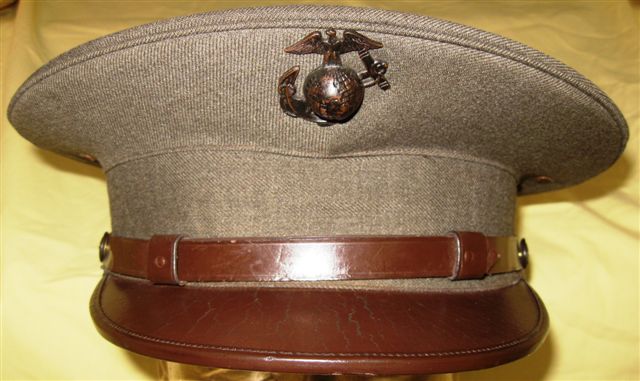
1922 Pattern Winter Service Cap. The EGA on this cap is the 1930 service pattern
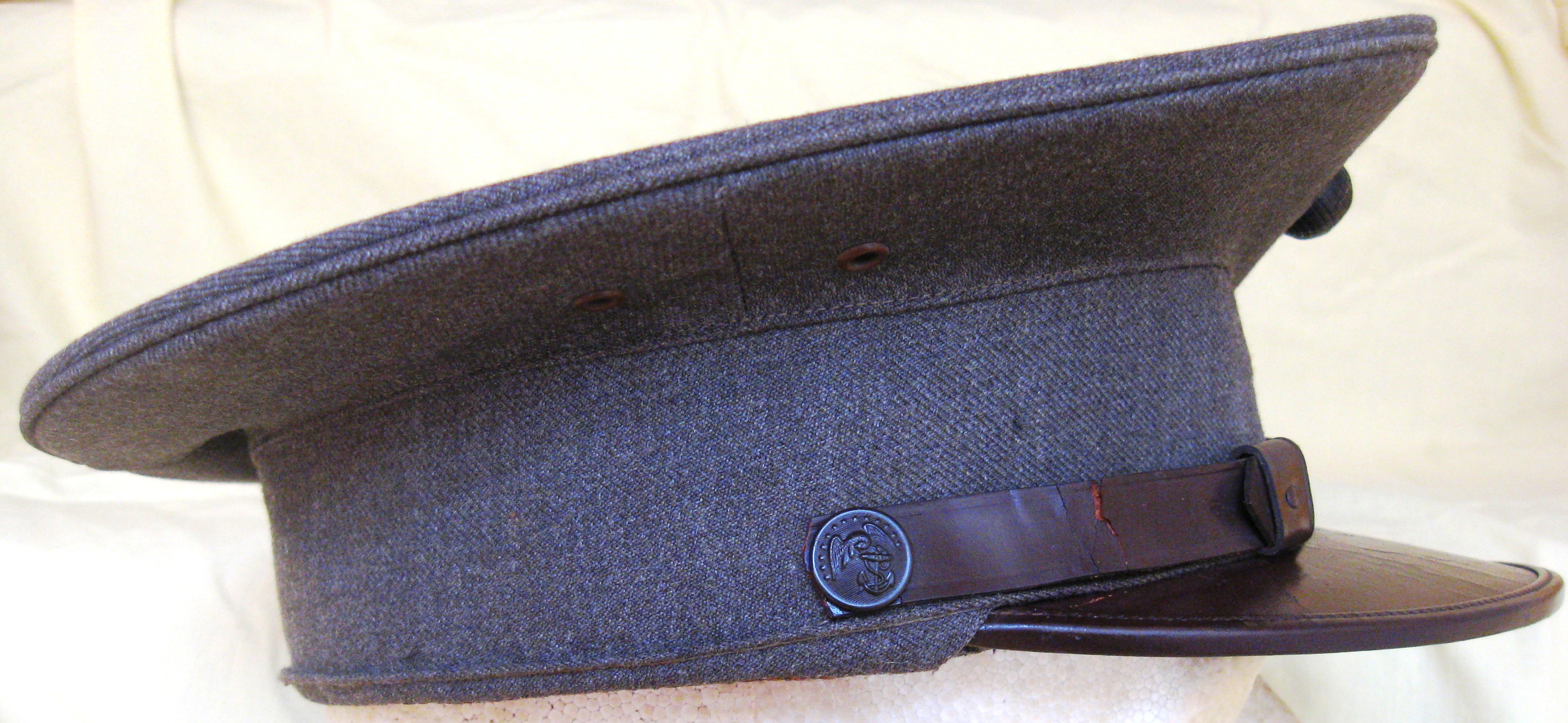
Profile of the 1922 Winter Service Cap
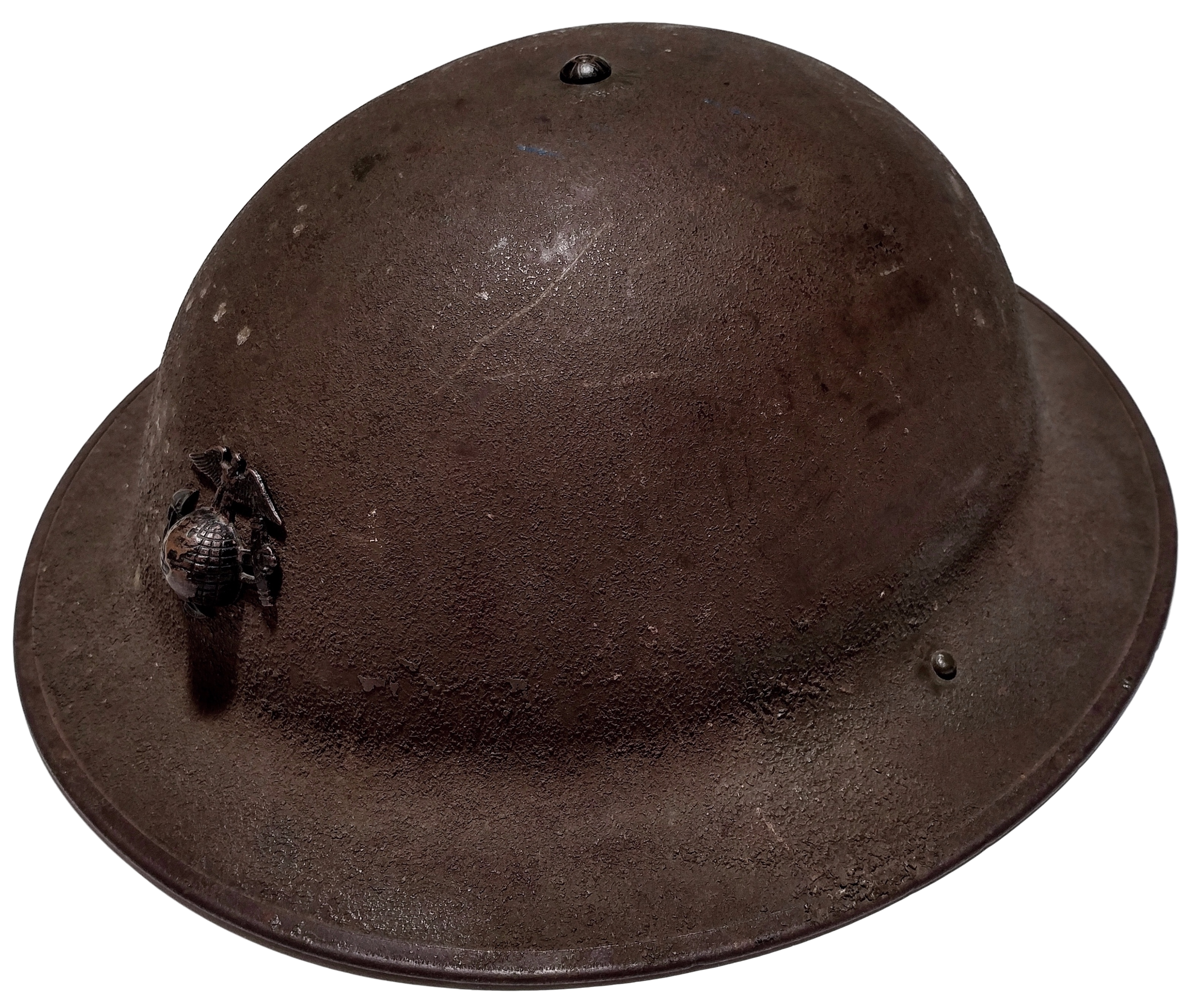
The M-1917A1. In the spring of 1937 the 4th Marines received this type of helmet, finally replacing their smooth finished WWI era M-1917s. Again the 4th continued the tradition of punching a hole in the helmet to mount an EGA. Photo courtesy of the Michael Skriletz Collection

Note the helmet's rougher finish. Prior to this time the 4th sanded their helmets down so they dispalyed a smooth finish. In addition, photograpghs of Marines along the Soochow, show they repalced their shiny brass EGAs with the black painted bronze service EGA. Photo courtesy of the Micahel Skriletz Collection
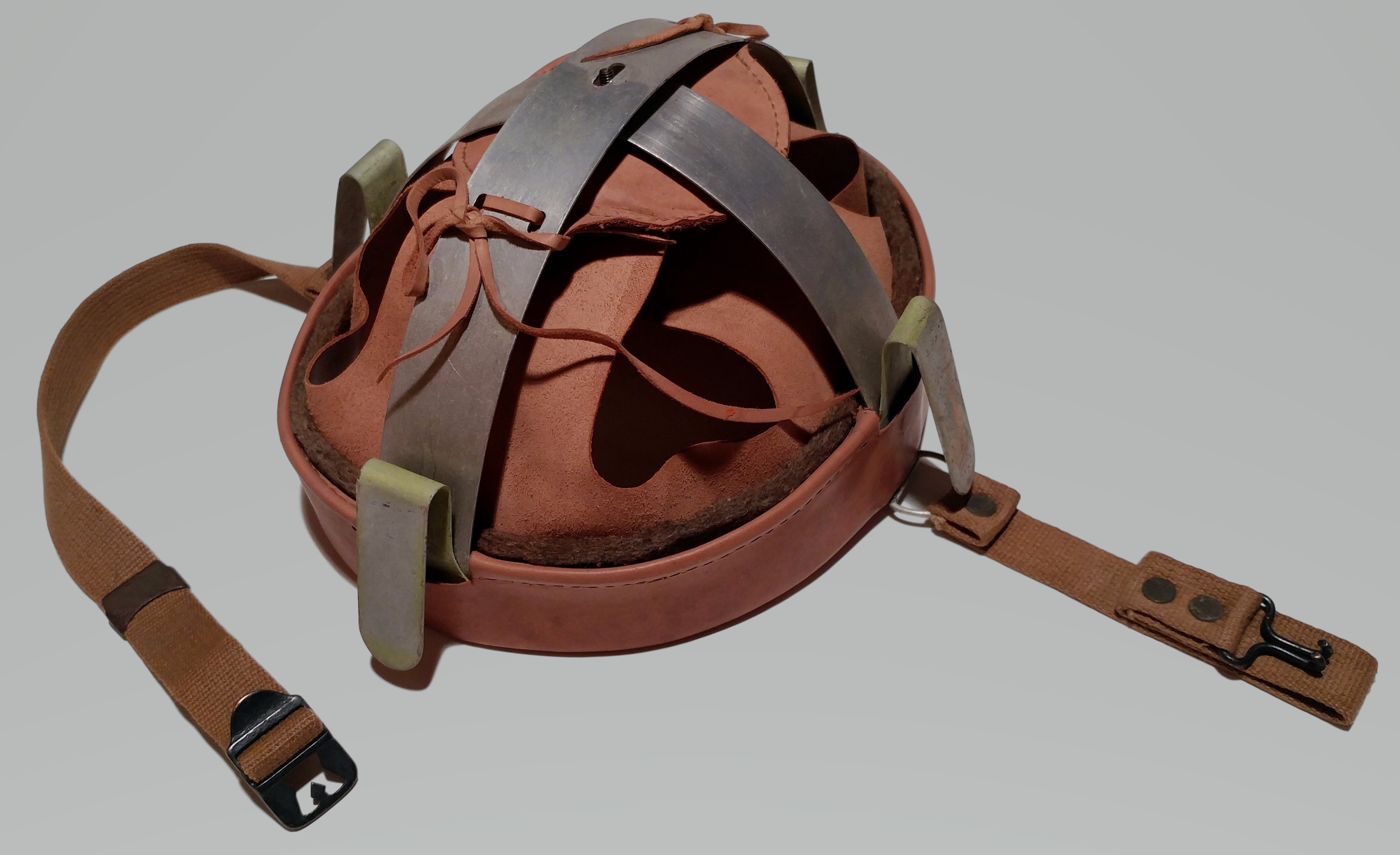
Liner of the M-1917A1. Per Mr. Skriletz the liner was redesigned to include new webbing and chinstrap, that repalced the older leather strap. Photo courtesy of the Micahel Skriletz Collection
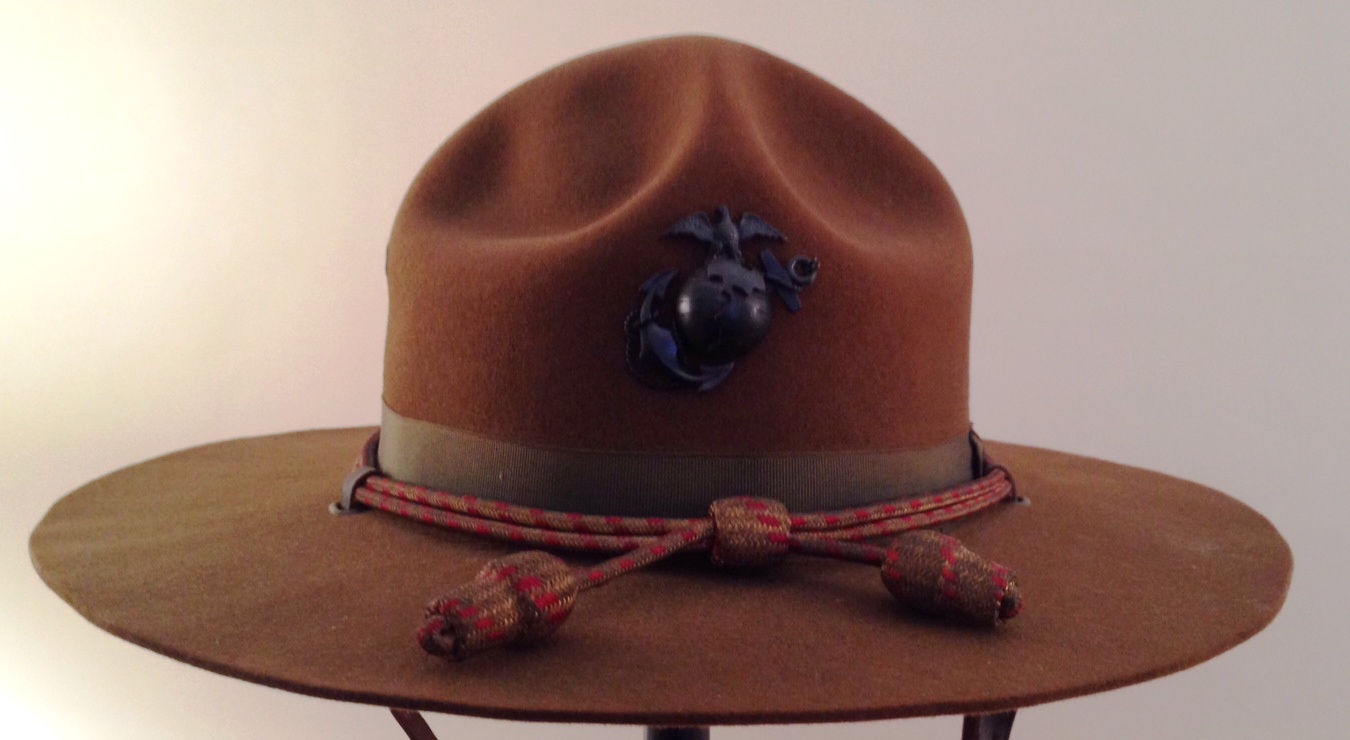
Officers Private Purchase Field (Campaign) Hat. C. late 1930s
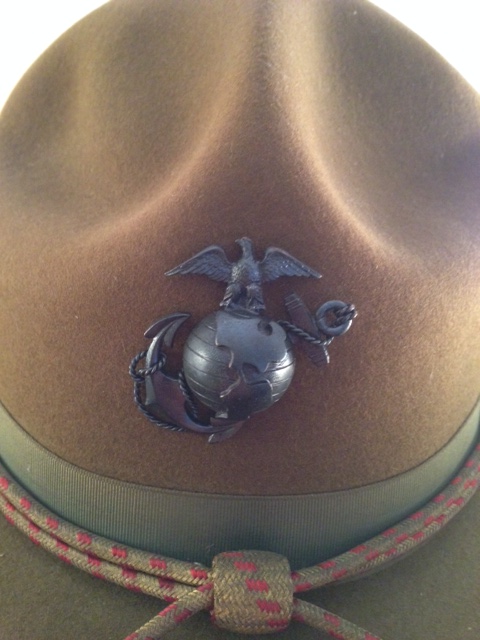
A detail of the EGA and Officers coords
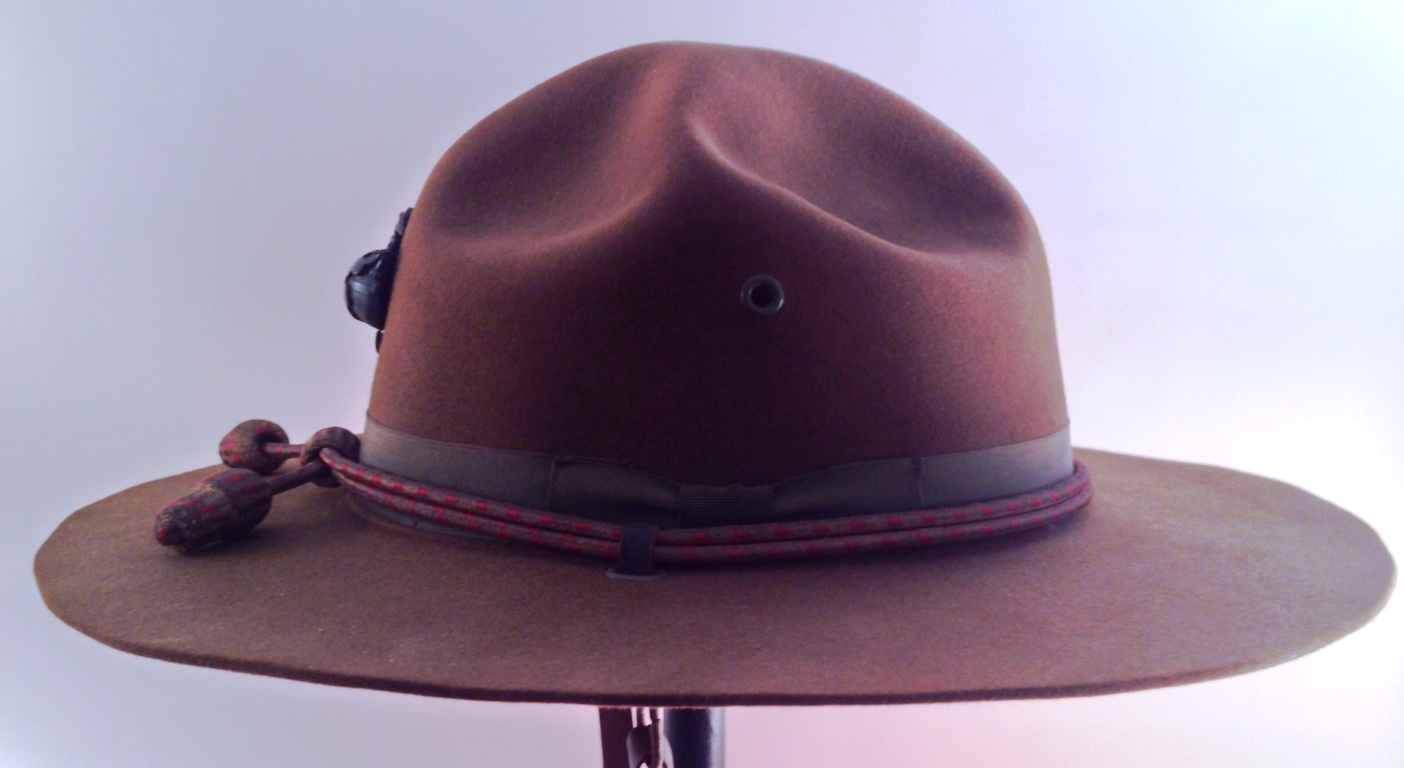
Uniforms:
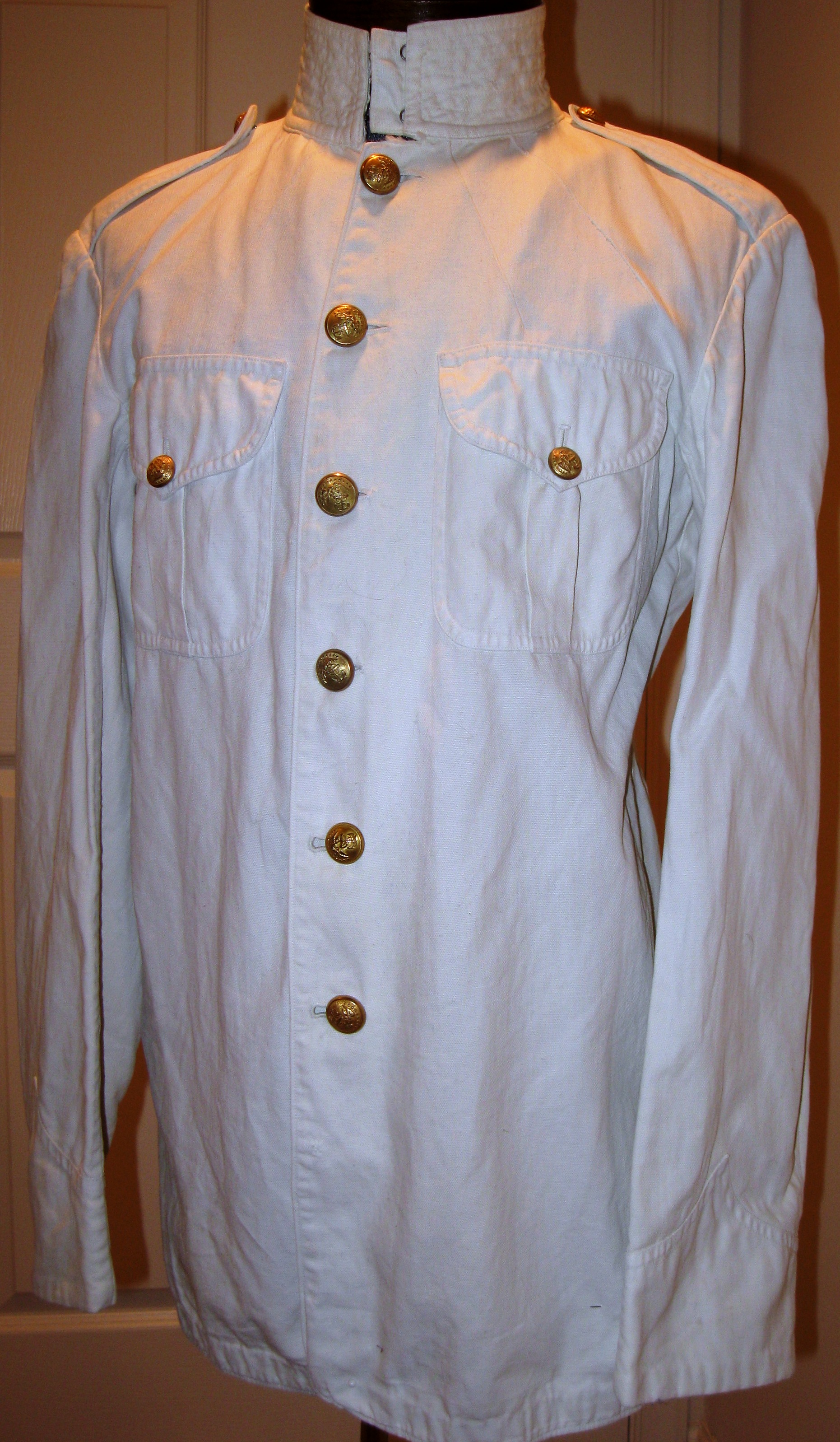
Fatigue Uniform, c. 1903-10. 1899 Pattern. Before the Marines adopted a khaki uniform for either summer or fatigue duty, they wore white. I’ve identified two styles of white fatigue uniform prior to 1910. The first type, earlier, had six brass buttons running down the front of the coat, but lacked pockets. Sometime after the Spanish American War I believe the Marines adopted a five button model, with two chest high front pockets. The model shown here is something of a hybrid- six buttons and two pockets. The coat is constructed of a white linen-like material. The buttons are by Horstmann of Philadelphia, and held by rings. There are no Quartermaster stamps visible inside the coat, but there is a size marking “IV” along the inside button line. This coat appears to have a modified collar. This "quilted" style collar has been noted in an image of Marines in Tientsin during the Boxer Rebellion, possibly indicating an Asiatic station custom modification by local tailors. The coat also has the names of three Asiatic Marines owned it at some time or another. What is interesting is that all of these men can be traced to having served in the Far East between 1903 and 1910. The first man to wear the coat was probably issued it in conjunction with his arrival in the Far East in August 1903. After serving for several months aboard the USS Kentucky, he transferred to the Philippines and subsequently in 1904 to the US Naval Hospital in Yokohama, Japan. In 1906 at the end of his enlistment he was sent home, and another Marine who had been on the USS Ohio came to Yokohama. His name appears stenciled inside the coat in proper fashion-initials of the first and middle name, followed by the last name fully spelled out. Just prior to his return to the United States, a third Marine obtained the jacket upon his arrival at Yokohama. This man, Howard Delong, carried the jacket through the remainder of the Asiatic cruise and return to the United States.
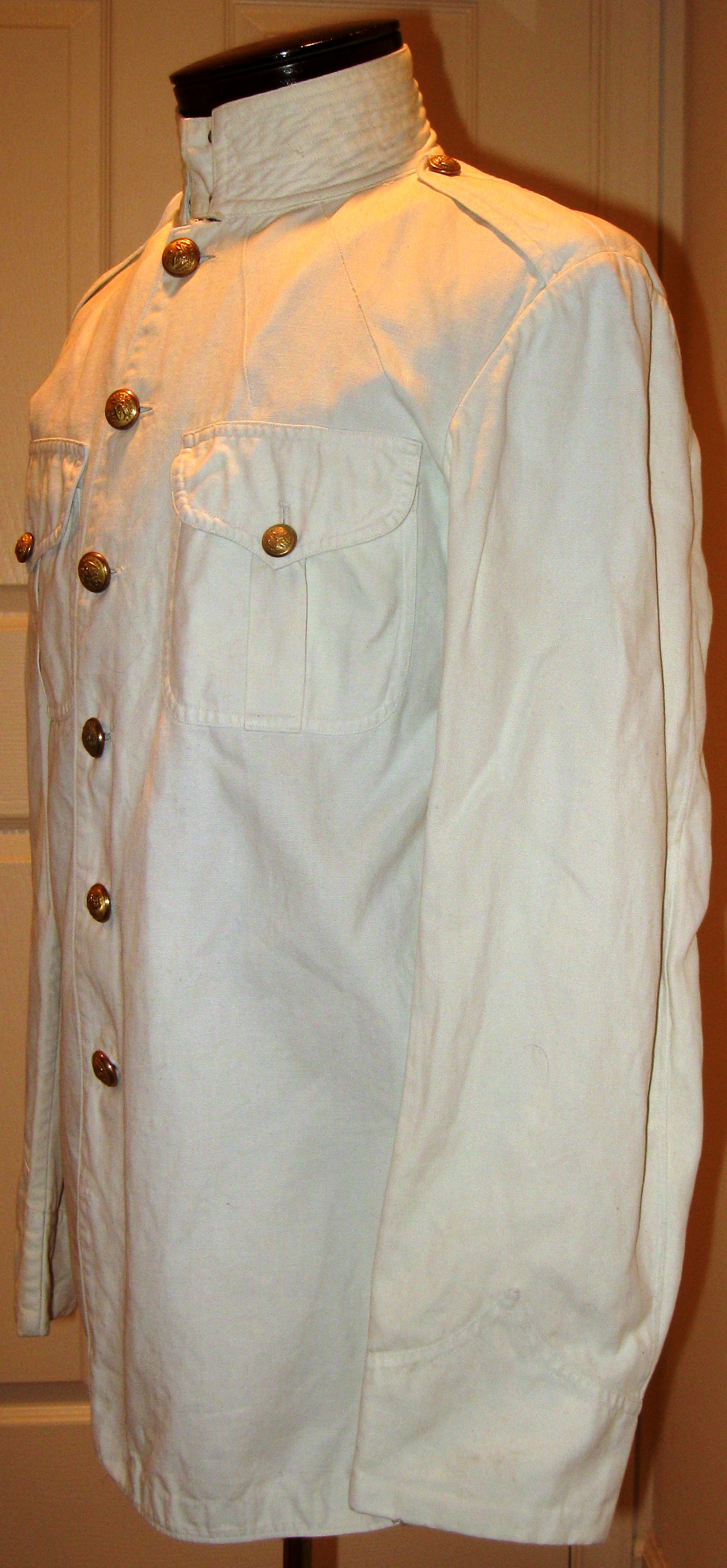
Here in profile you can see the pointed cuffs, a classic feature on all Marine fatigue uniforms for years to come. Sometimes these uniforms are found dyed a grayish color or a light brown.

Enlisted Man's 1912 Pattern Summer Service Field Coat. This particular coat was resissued to several Peking based China Marines before WWI.
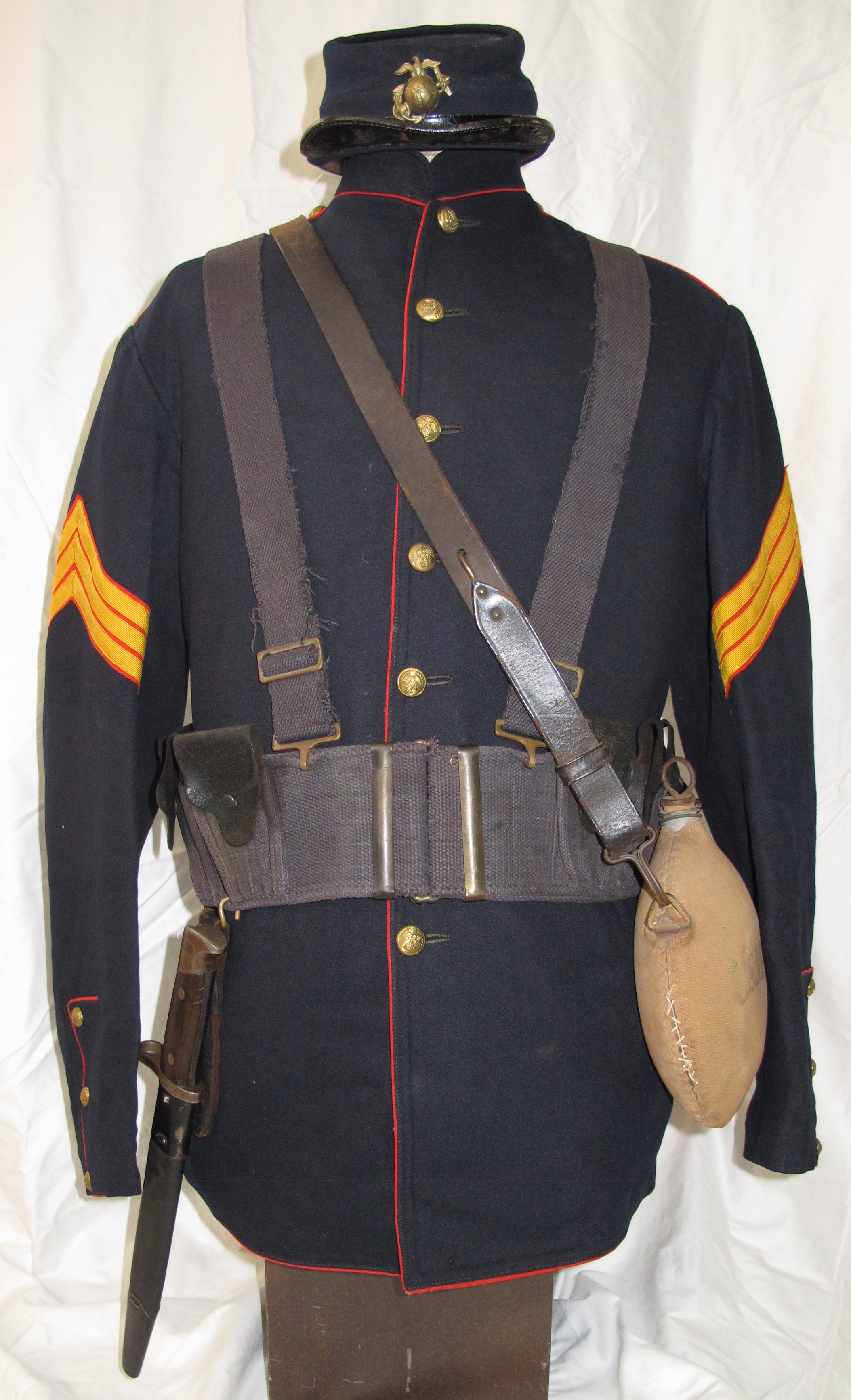
A Marine Sergeant as he might have appeared while serving in a landing party just prior to the start of the Spanish American war. Note the 1875 pattern hat. Although many Asiatic Marines were wearing the new 1897 cap, photos do show a few Marines still wearing this pattern up to the Spanish American War period. The uniform is the 1892 enlisted man's undress service uniform. Courtesy of the Mike Manifor Collection
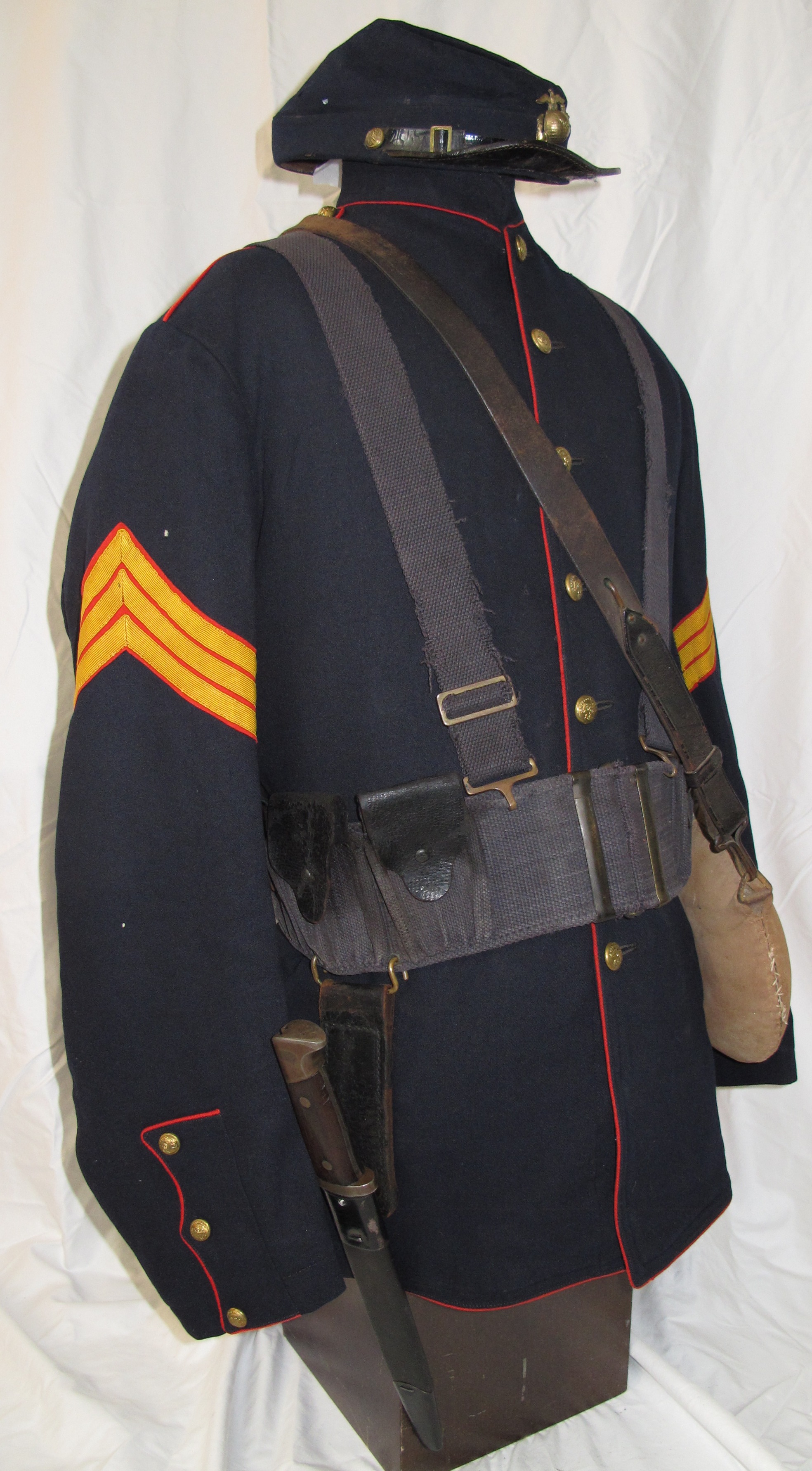
Note the very rare 6mm catridge belt. Courtesy of the Mike Manifor Collection
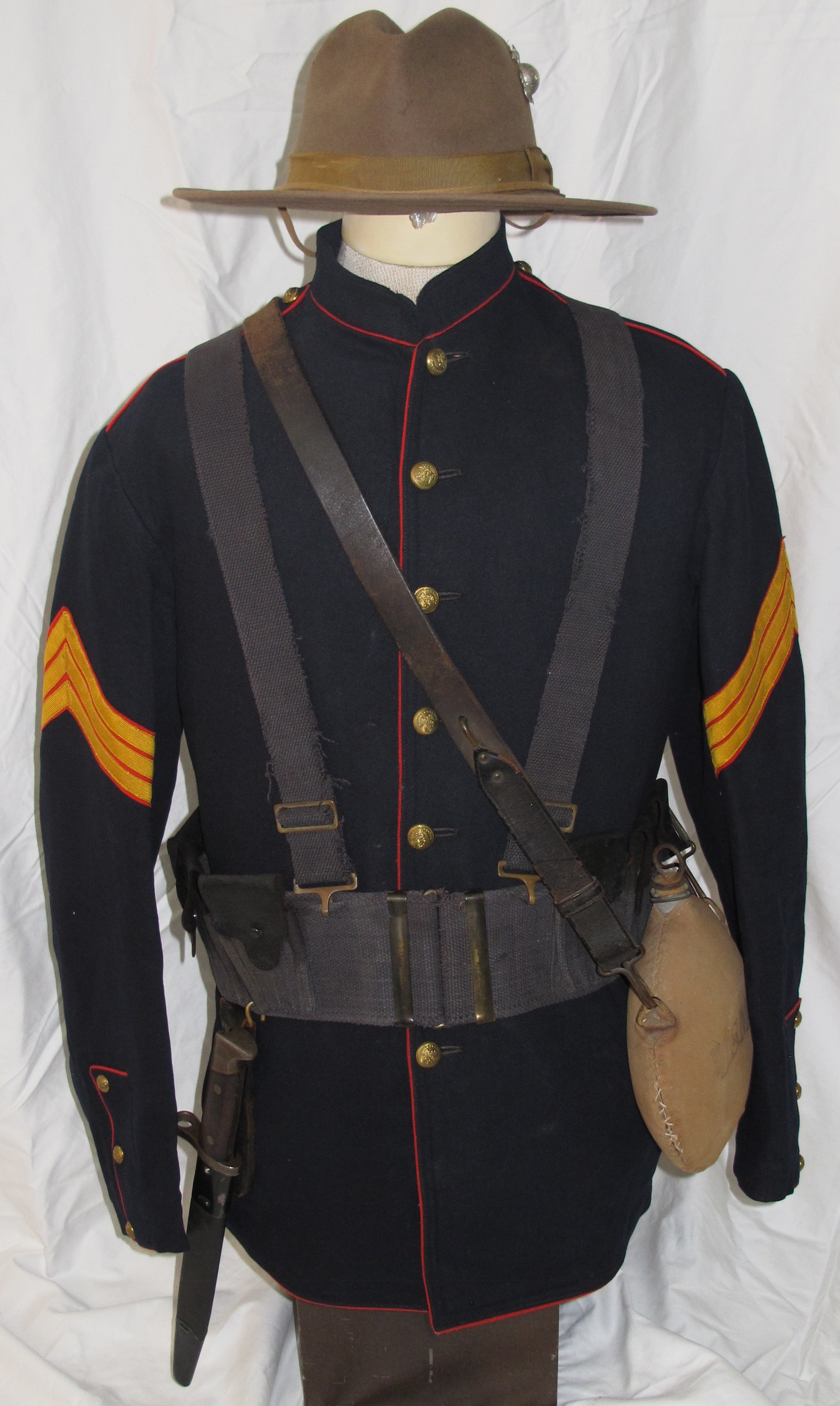
A Marine Sergeant as he might appear while in defense of the American Legation, Peking 1900. When the Marine defenders arrived in Peking, they only brought with them one uniform, their blue undress uniform as shown above. Note the 1898 Field Hat with EGA mounted on the side of the hat. Photos taken during the Boxer Campaign shows many men of the relief force shifting the EGA to the front of the hat, vice the side, to conform with Marine Corps regulations of 1900. Other Marines however continued to wear the EGA on the side or no EGA at all. Courtesy of the Mike Manifor Collection
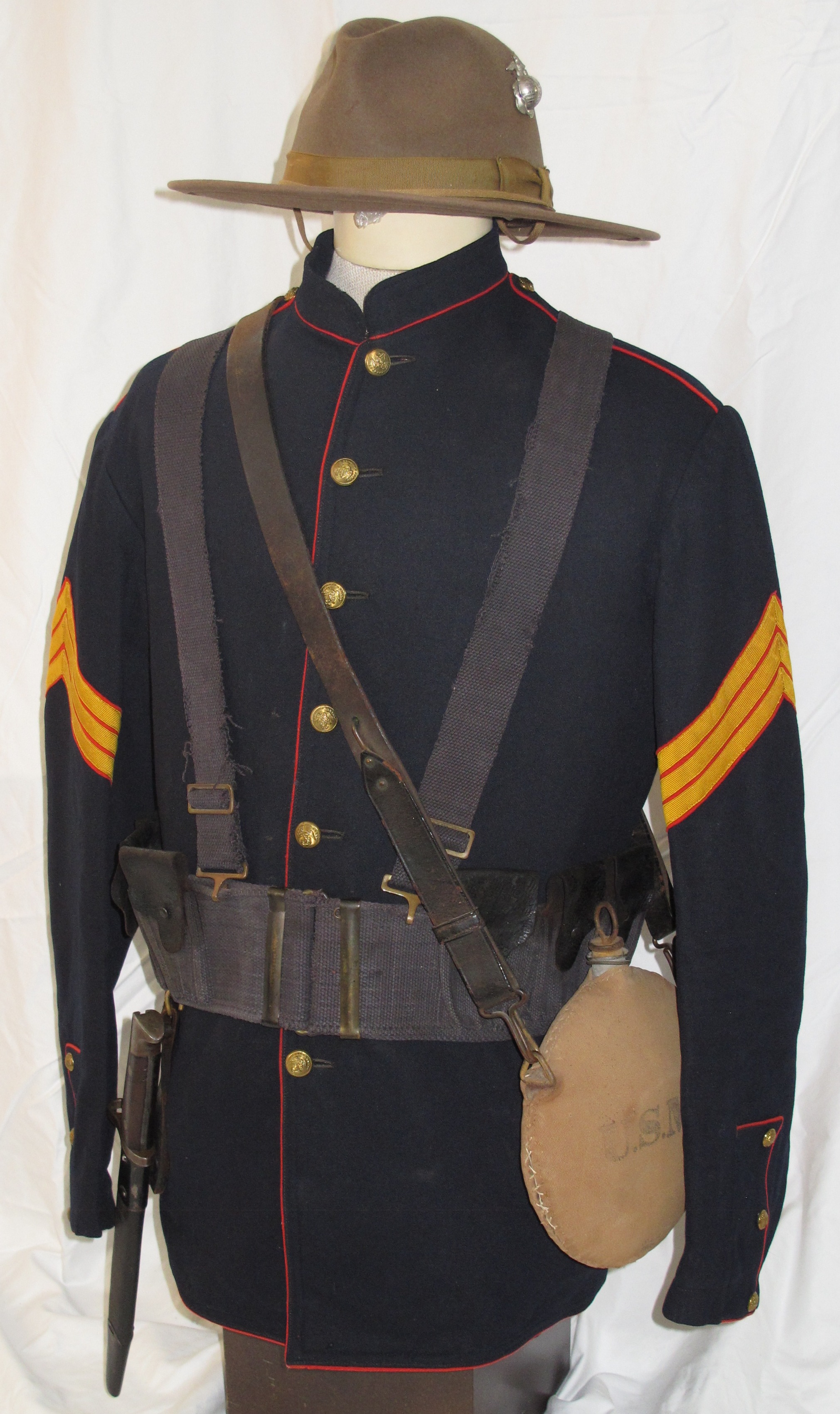
Courtesy of the Mike Manifor Collection
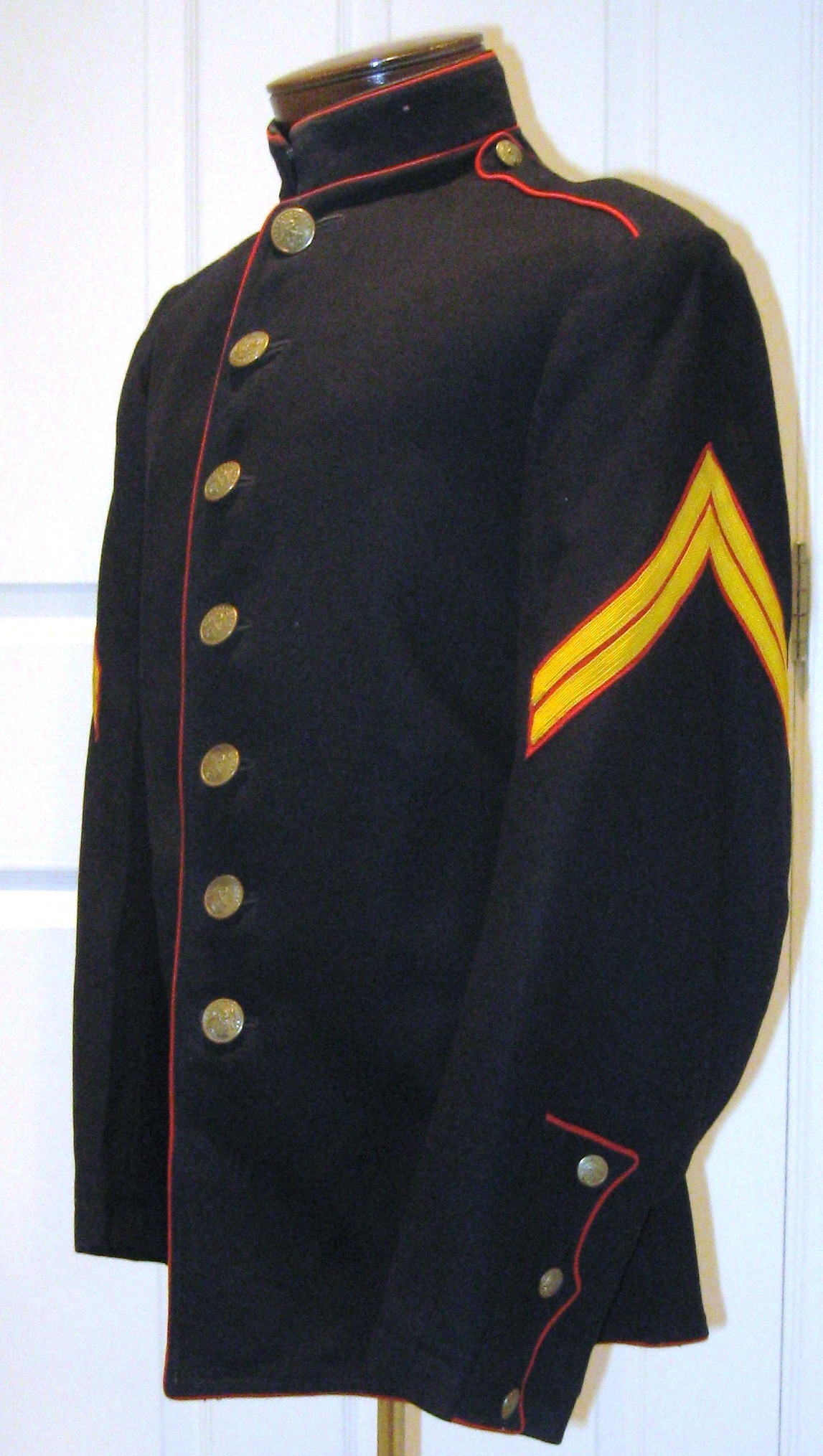
Undress Coat, Corporal. As a result of the 1904 changes to the uniform regulations the Marines adopted this style of coat for undress wear. After 1912 it became the dress coat, when they adopted a winter (forest green) and summer (Khaki) field coat. Although the collar differs from the SpanAm era coat, the Marines retain the large seam-to-seam stripes as shown here.
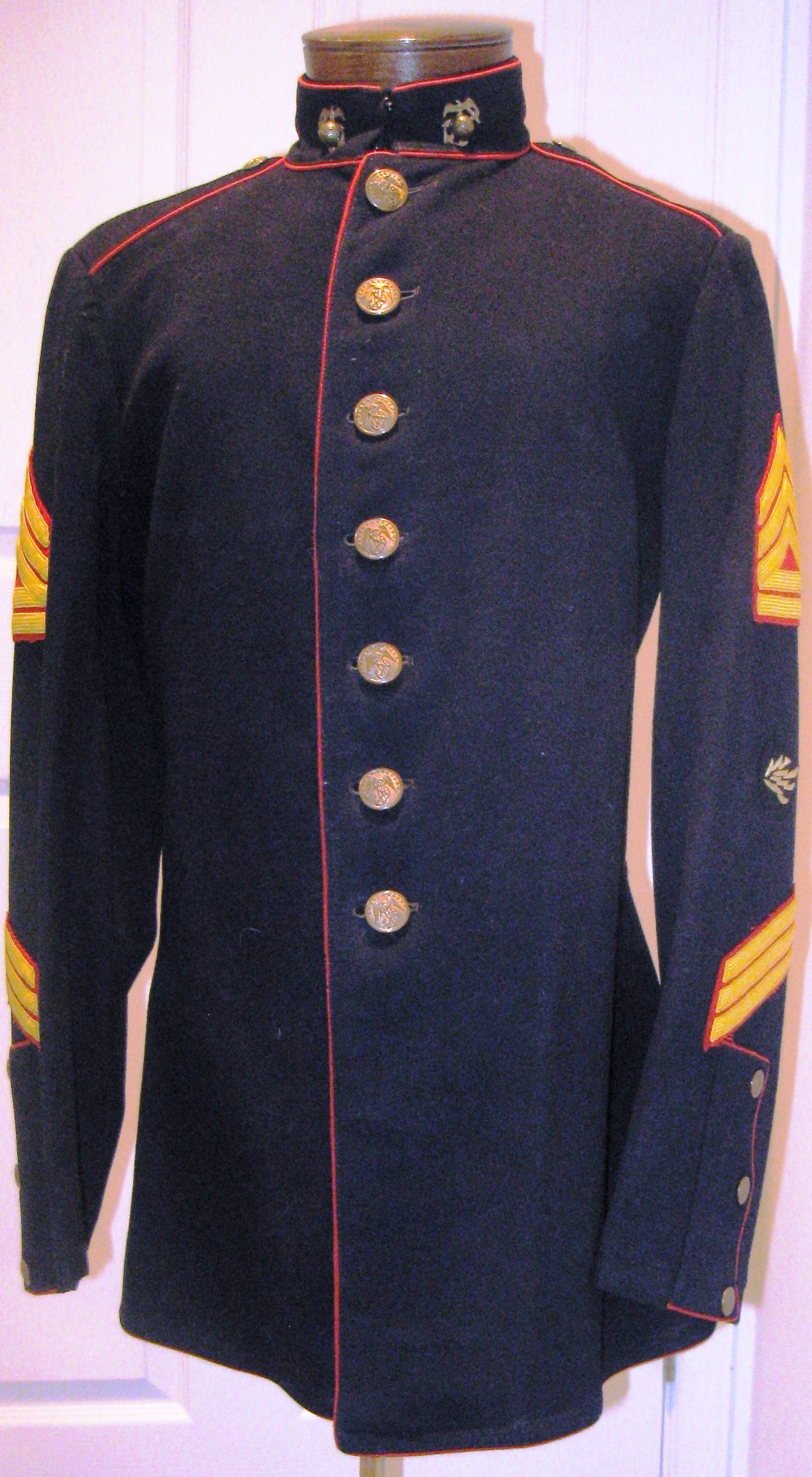
Dress Coat, c 1935. This coat is similar to the previous example, except now the Eagle Globe and Anchor (EGAs) ornaments are worn on the collar. The collar EGA for enlisted men was adopted immediately following World War I. In addition, the stripes, in this case those of a Technical Sergeant, are now much smaller than the larger seam–to-seam style which was phased out in 1922. The tunic itself is dated 1930-31 and is named to a career Marine. Note the service stripes just above the cuff denote the Marine had three enlistments (12 years service). Above the service stripes is the Radioman insignia. The Marine was a radio operator at Peiping in the mid-1930s. It was not uncommon for China Marines to turn their uniforms over to the post tailor who would re-build the uniform to have a sharper, more fitted appearance
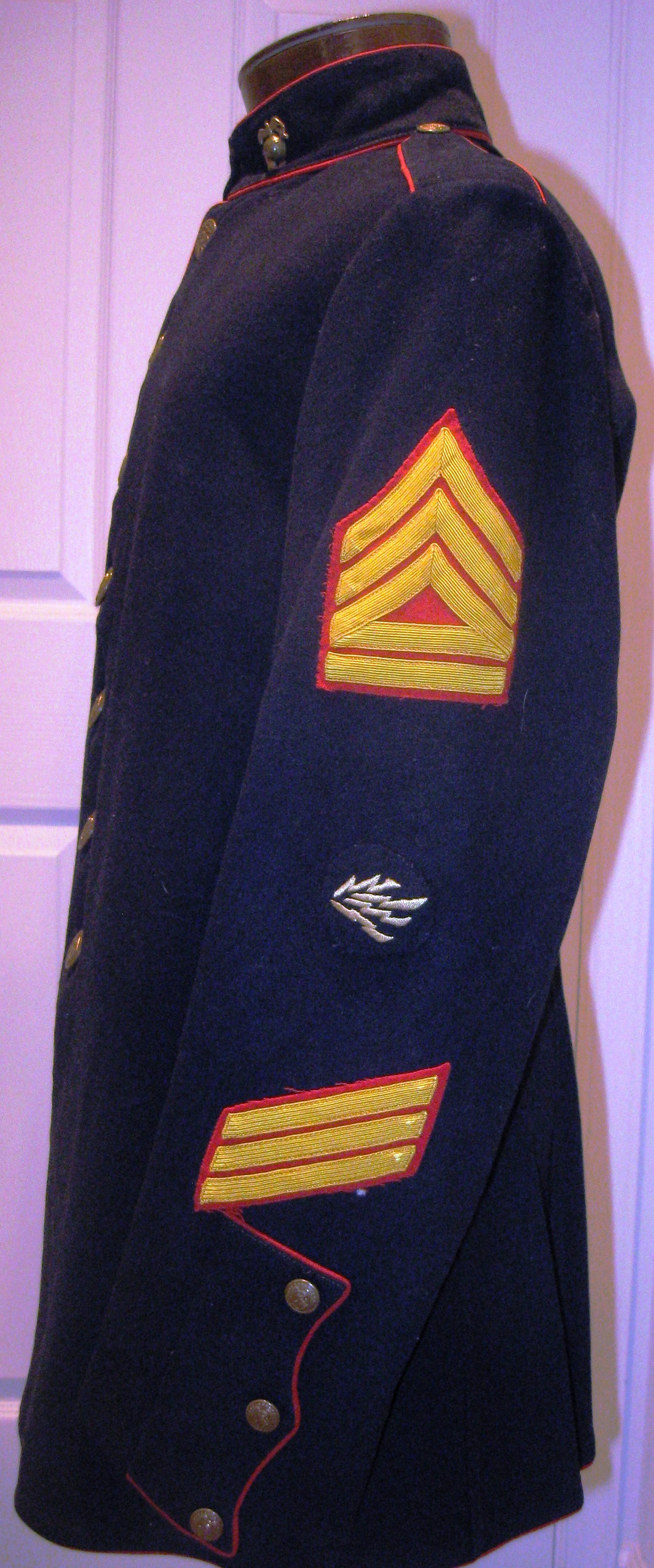

1929 Pattern Enlisted Winter Service Coat. This coat was worn by Corporal Irving Buckland, who was Tientsin-based in the late 1930's. The uniform is shown with a sharpshooters medal he would have been awarded while serving in China. The brown garrison belt was to be worn at all times, unless when wearing field equipment.
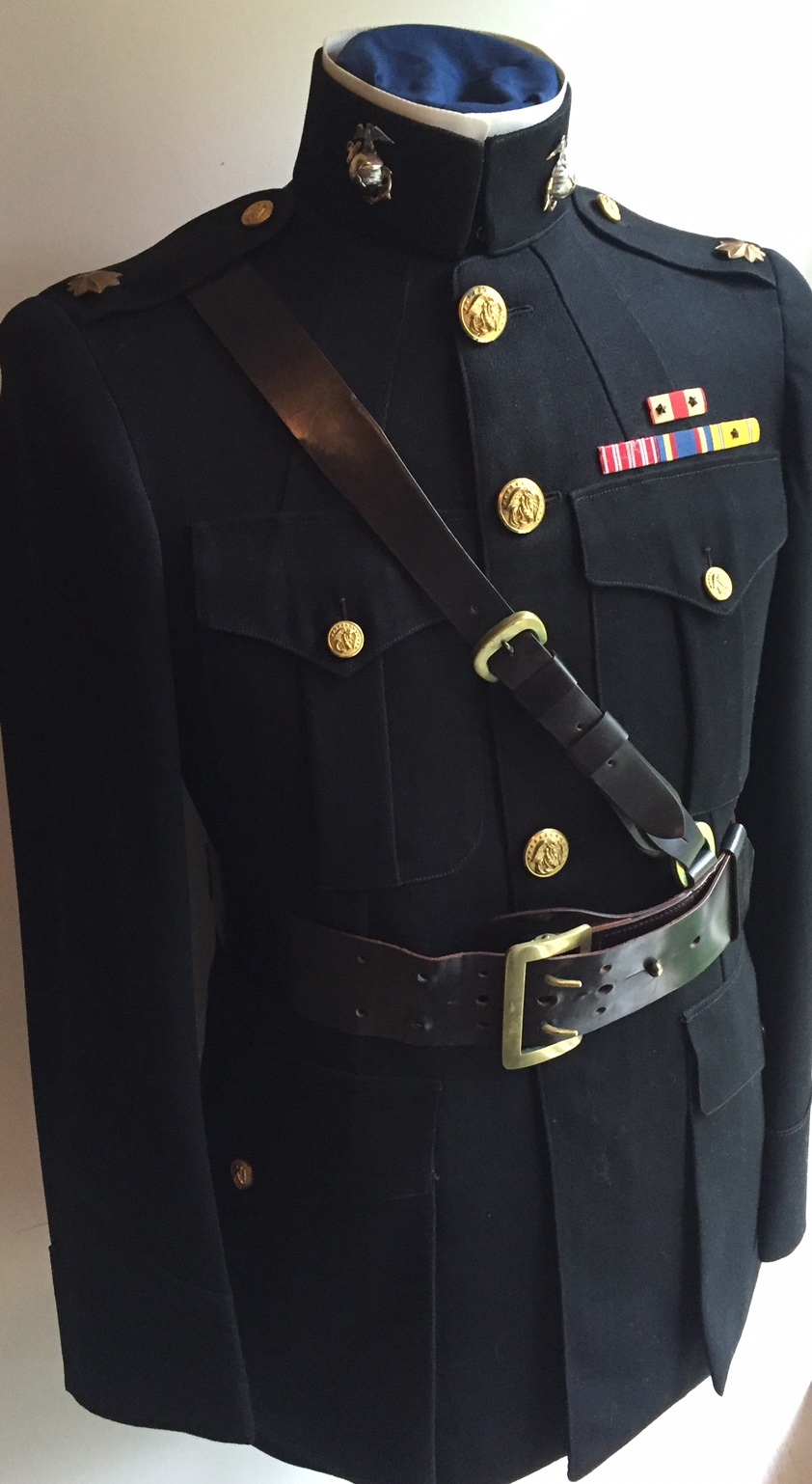
Officers 1922 Pattern Undress Coat. This coat belonged to a two cruise China Marine officer, Maj Tilghman Saunders. Saunders served both cruises with the 4th Marines in Shanghai in the 1930's. He would serve through World War II and retire as a Major in 1947. The uniform is shown with the cordovan Sam Brown belt.
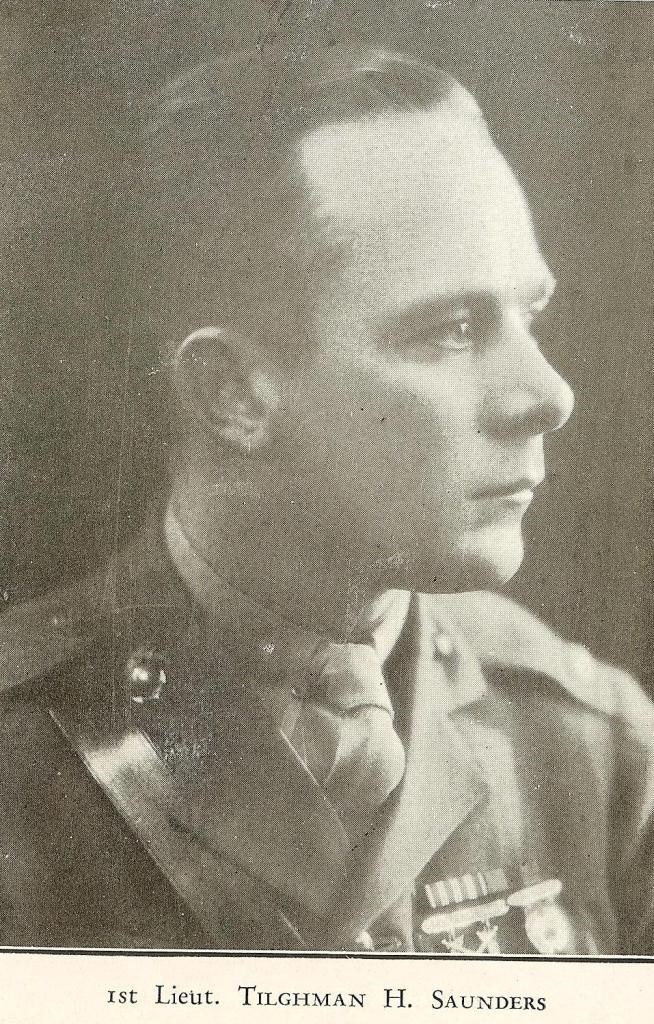
A photo of Saunders, as a 1st Lieutenant from the 1931-32 4th Marines Annual.
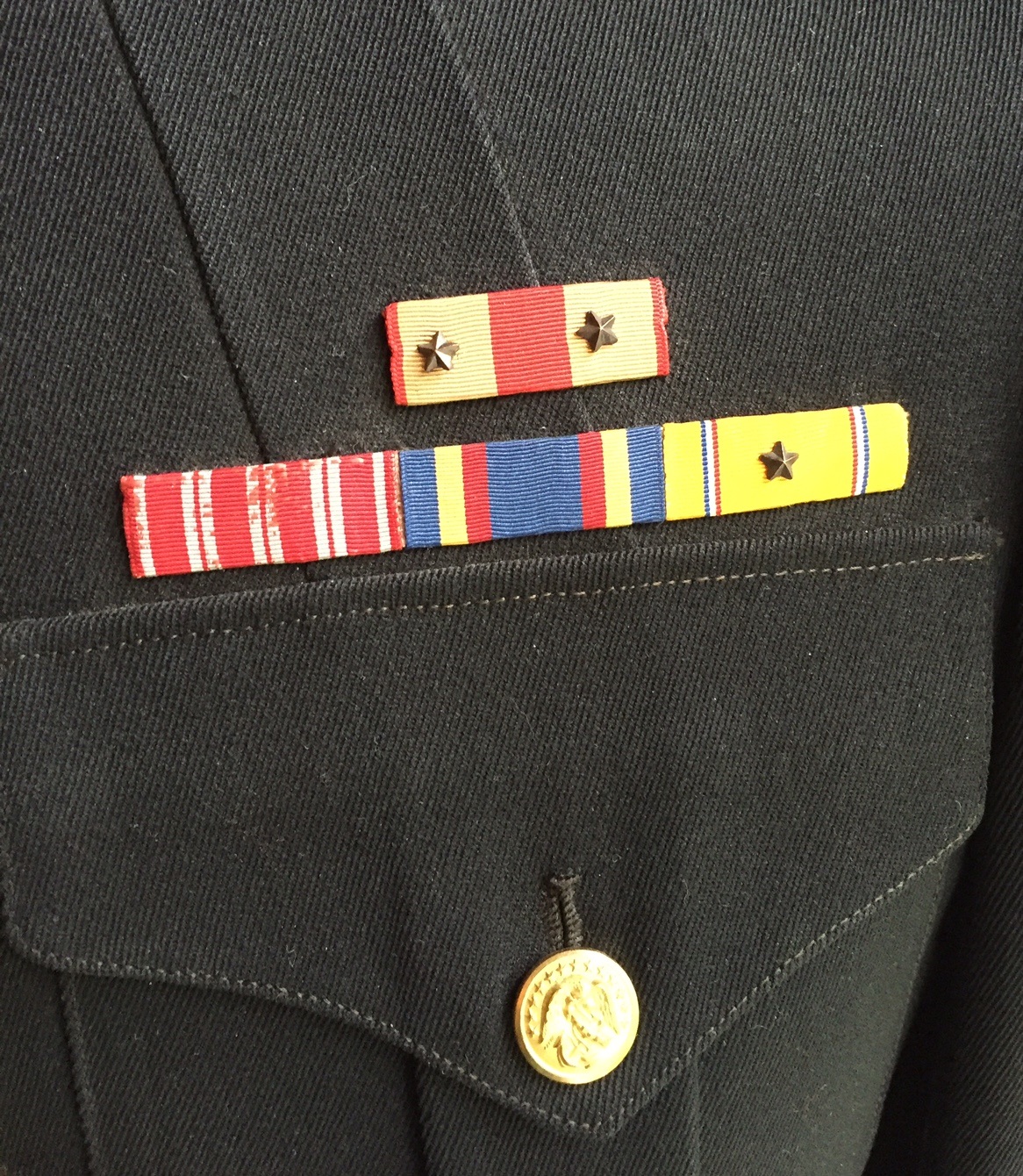
Saunders chose not to use the more common ribbon bar, and instead had his ribbons sewn directly onto the coat. The ribbons from top to bottom, left to right: Marine Expeditionary Ribbon with two stars, Second Nicaragua Ribbon, Yangtze Service Ribbon, and a American Defense Ribbon with star.

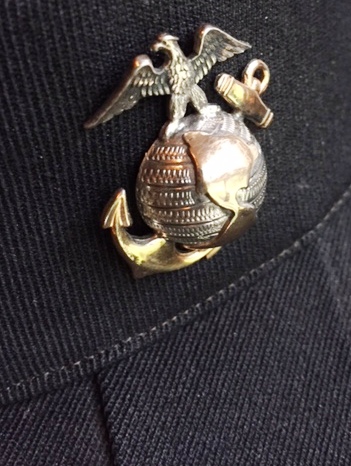
A close up of the 1937 Pattern EGAs.
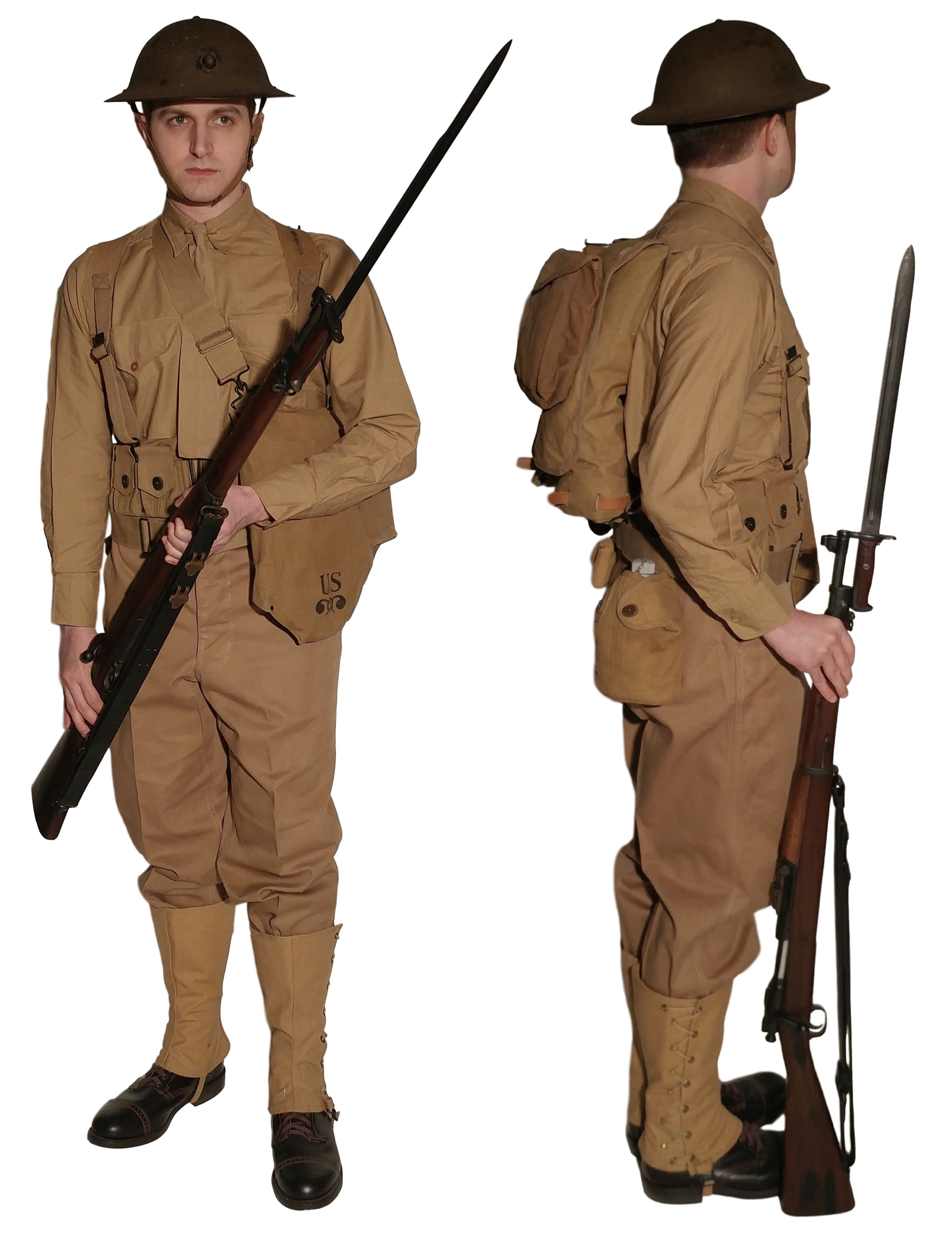
On the Soochow Creek. Collector and researcher Micahel Skriletz shows us a recreation of how a Marine would have appeared on the Soochow Creek, summer of 1937. Photos courtesy of the Michael Skriletz Collection.
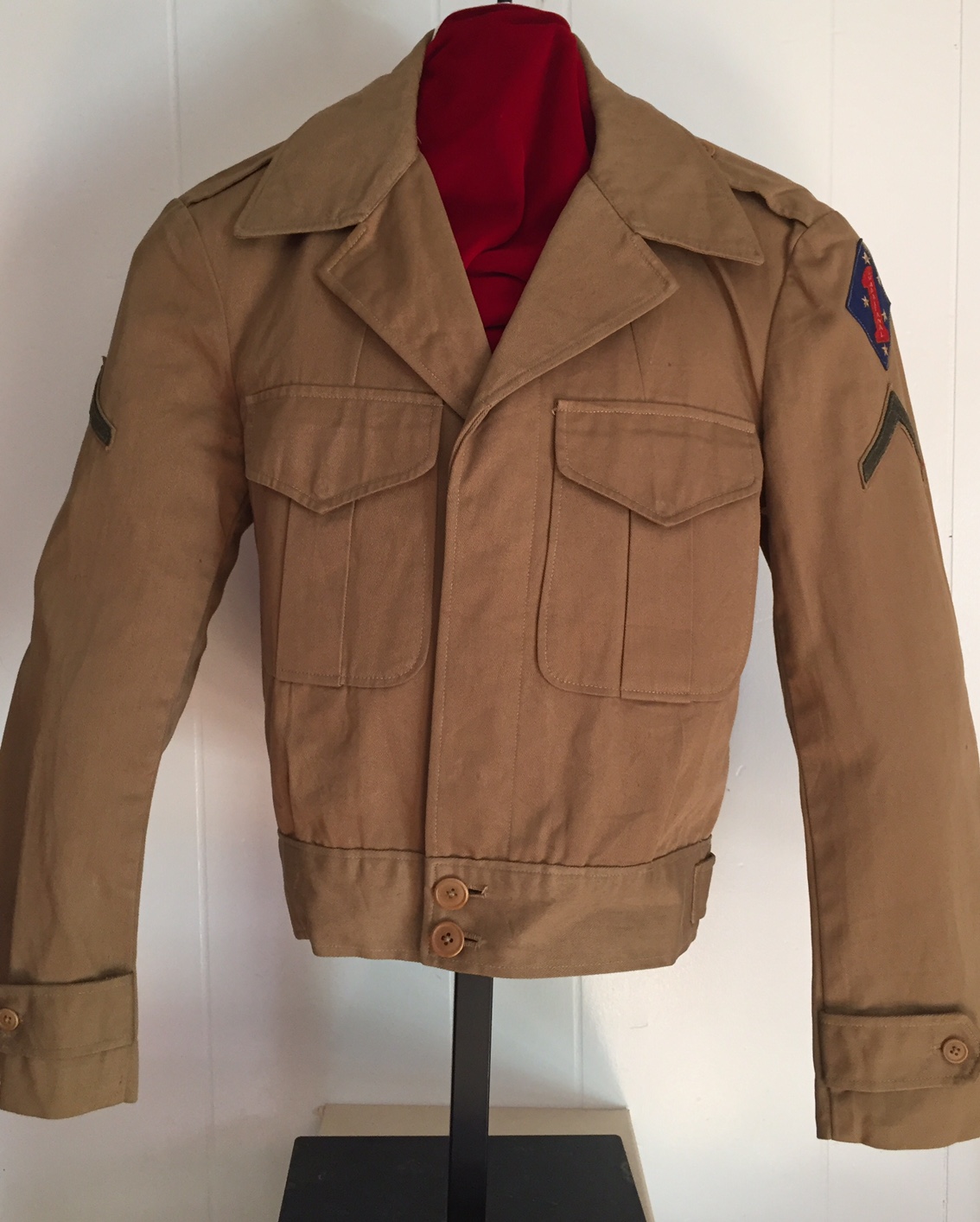
Post WWII Chinese made Vandegrift Jacket. This jacket, constructed post war was based upon a pattern that was authorized from 1945-47. The First Marine Division SSI is also Chinese made.
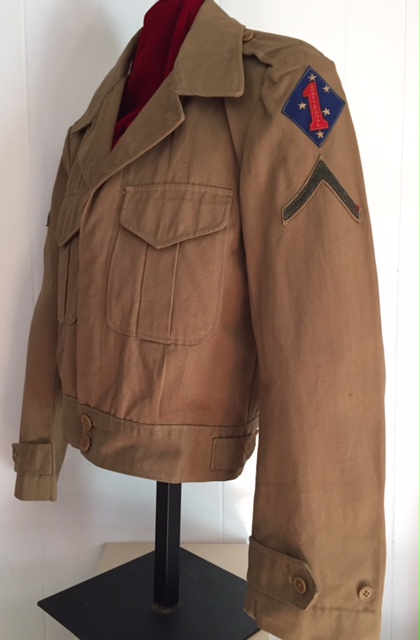
A profile view of the theater produced Vandegrift.
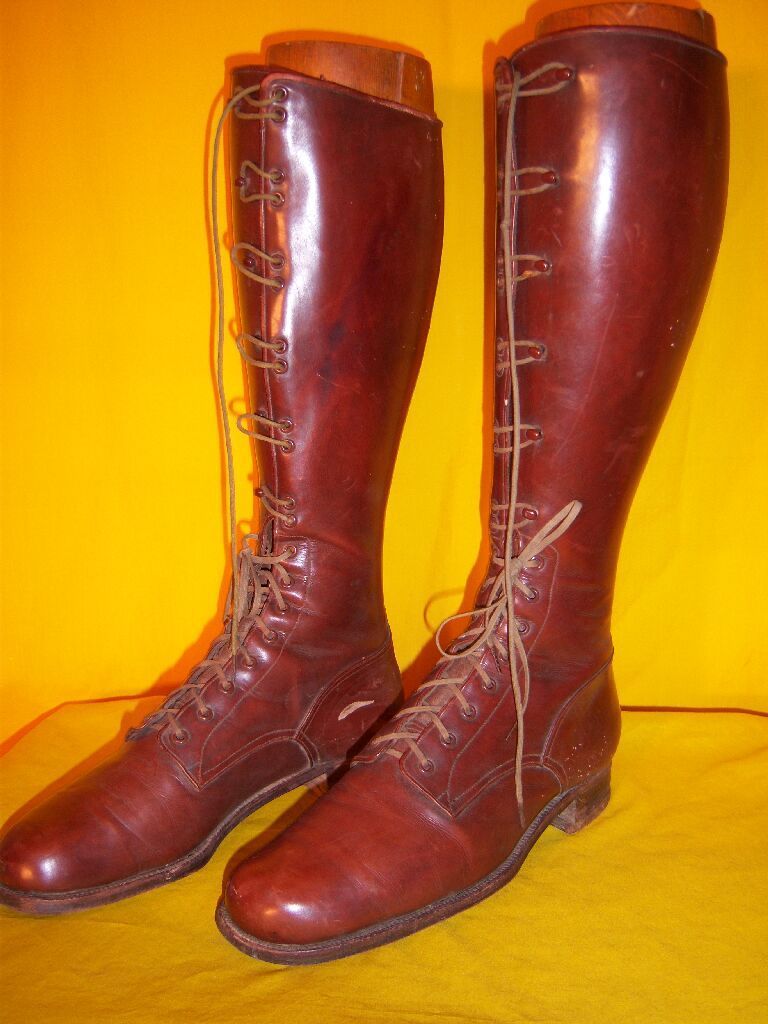
Mounted Detachment Boots. Courtesy of the MSgt Dan Whitton Collection
The Eagle, Globe and Anchor/Other Insignia
One of the most distinctive China Marine insignia items worn during this period was the hat diamond. These diamonds were color coded to correspond to each Marine company assigned to the Peking Legation. Diamonds were only worn on the winter fur cap issued to all North China Marines. Shanghai-based and Asiatic seagoing Marines did not wear this device on their headgear. The earliest reference I have seen about the diamond dates to early 1929. Prior to that year, Peking Marines would punch an EGA through their winter fur caps. The Marines probably developed the company diamond after noting both the British Legation Guards and the U.S. 15th Infantry in Tientsin wore their unit crests on their winter headgear. This site is fortunate to show several examples of the Peking Diamond, from the collection's of Mike Manifor, the Brown family and the Dennin family. The yellow enamel on the three diamonds below associates them with another China Marine institution, the Mounted Detachment.
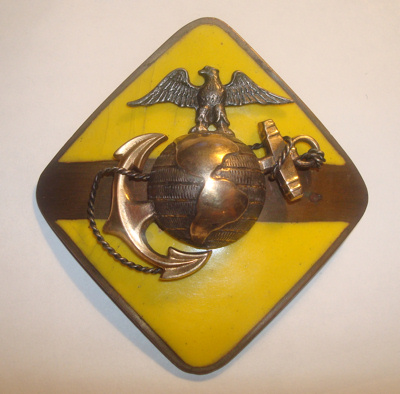
Officer's Hat Diamond of the Mounted Detachment
Diamond courtesy of the Mike Manifor Collection
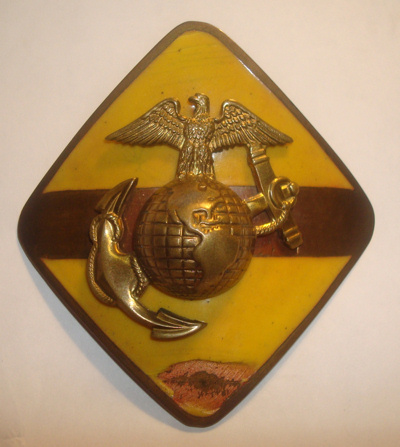
An Enlisted Man's Hat Diamond for the Mounted Detachment
Diamond courtesy of the Mike Manifor Collection
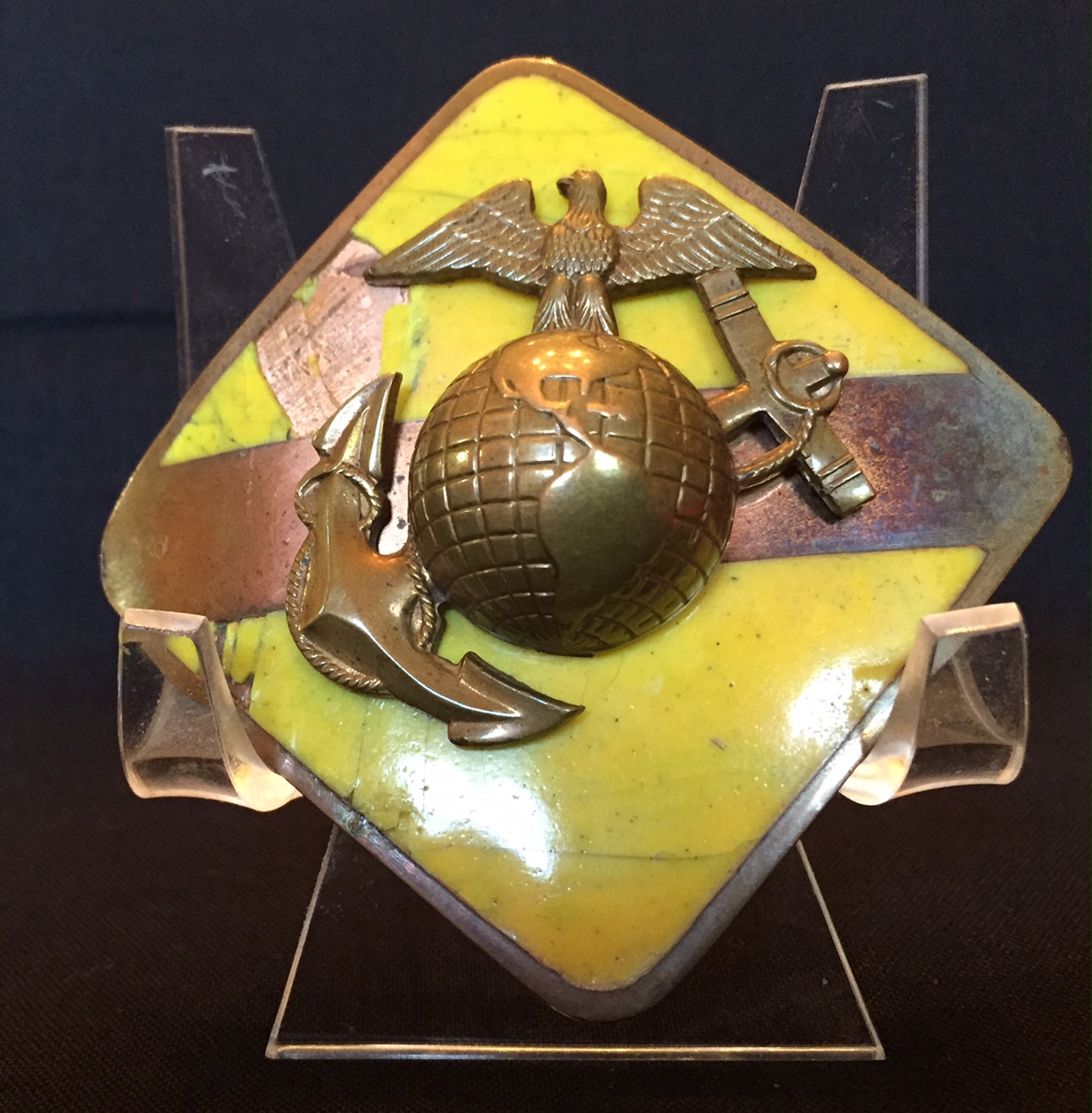
Another Mounted Detachment Diamond. Although damaged, it allows us the opportunity to see the surface below the enamel
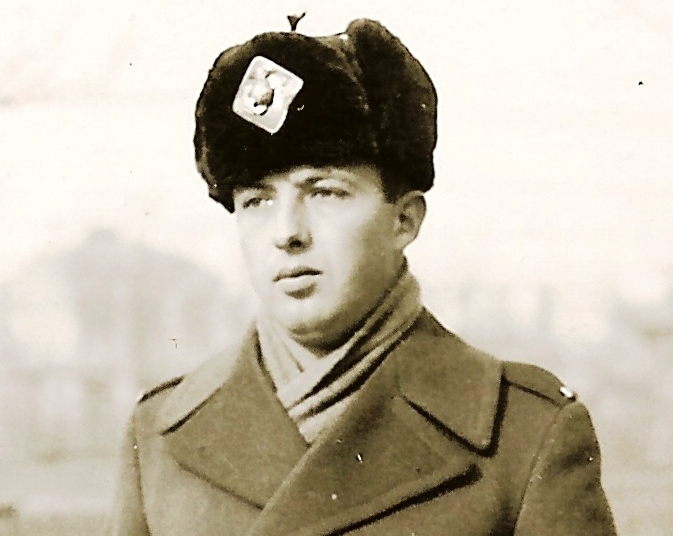
Lt Fred Ramsey, Commander Mounted Detachment wearing a Peking Company Diamond in his winter hat
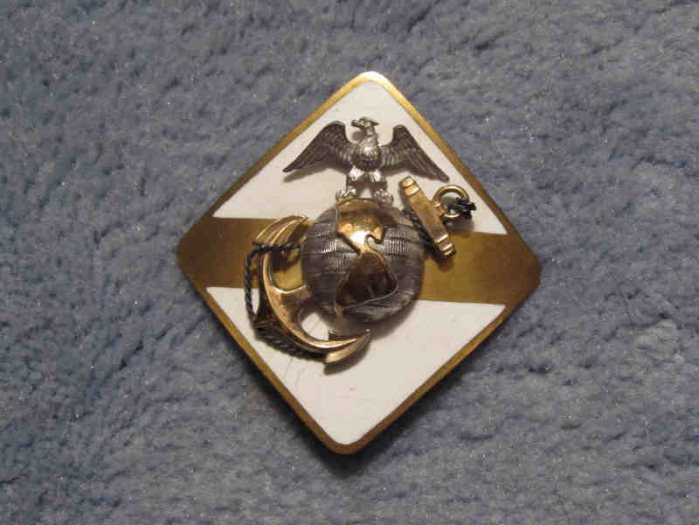
Captain Robert S. Brown's Hat Diamond. A White Diamond was used to indicate Headquarters Company
(Device courtsey of the family of Robert S. Brown)
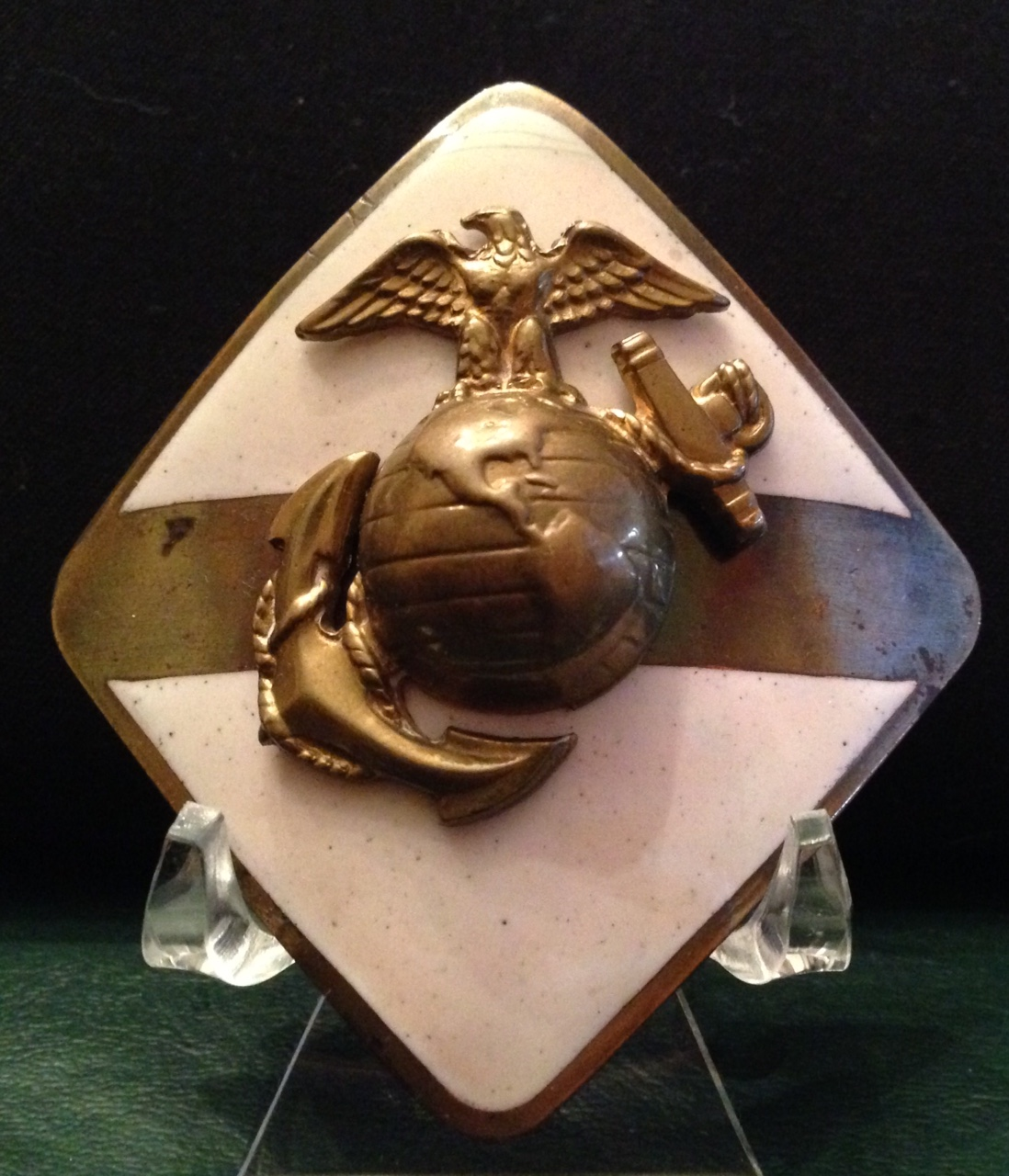
An enlisted man's HQ Company Diamond. This diamond is attribted to a Bandsman. Note he choose to replace his 1930 pattern EGA with the later 1937 pattern. He was stationed in Peiping through the mid to late 1930's.
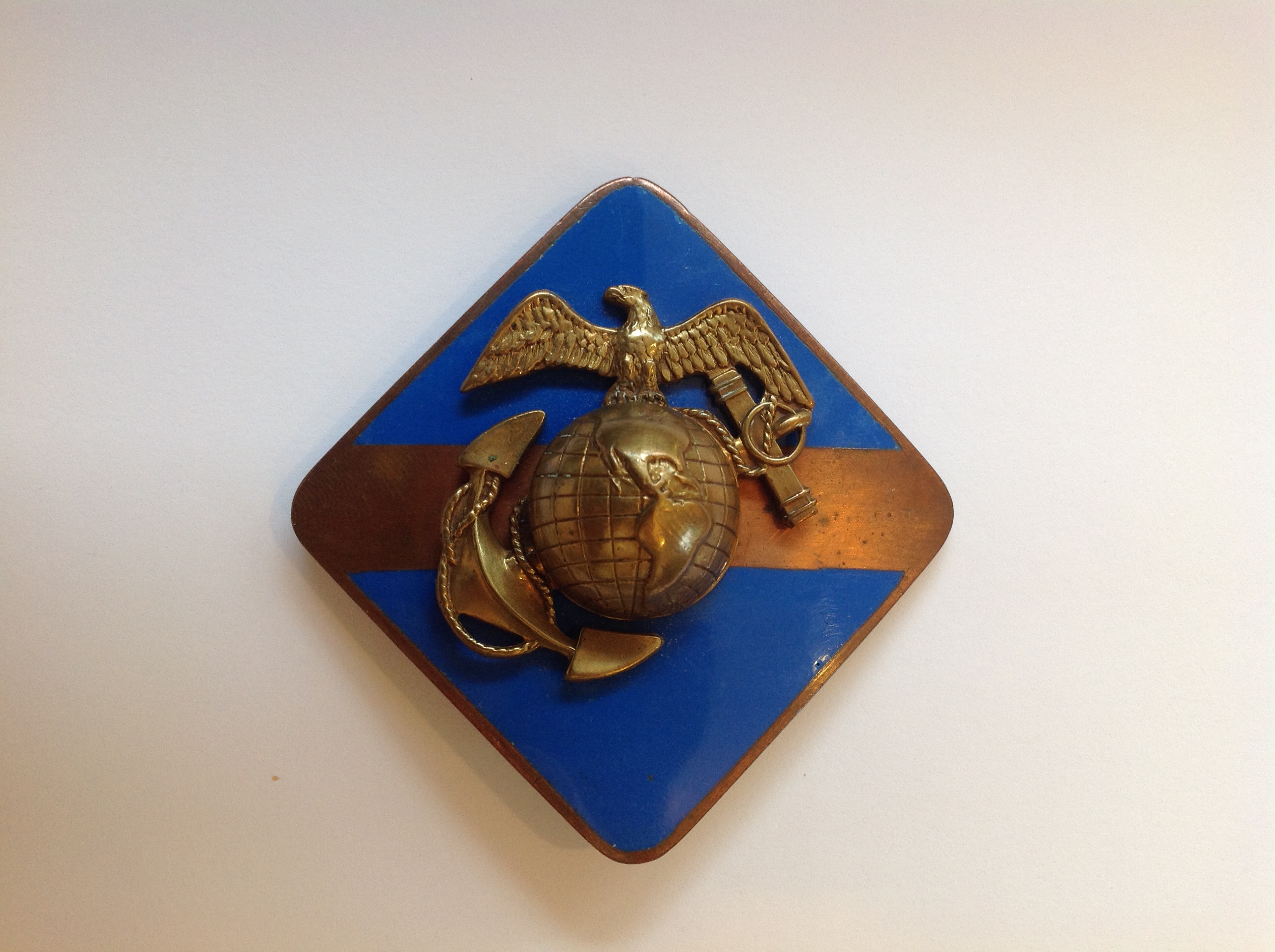
Private First Class William A. Dennin's Blue Company Diamond. Blue was used by A Company (the former 38th Company). Photo courtesy of the Dennin Family Collection
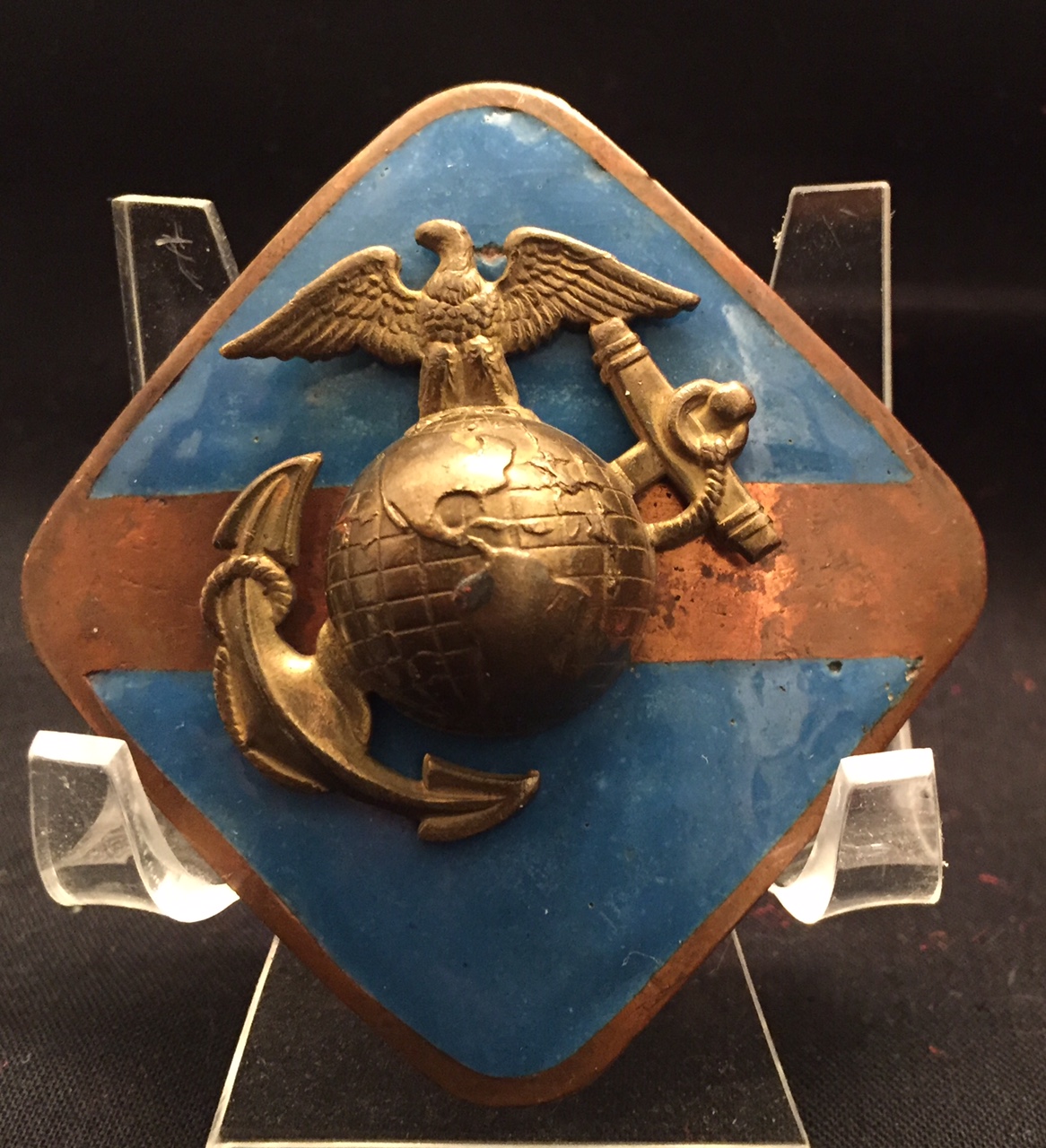
Another A Company Blue Hat Diamond. Note the variation in color between this A Company diamond and the Dennin family diamond above. Given the handmade nature of these devices such variations are to be expected.
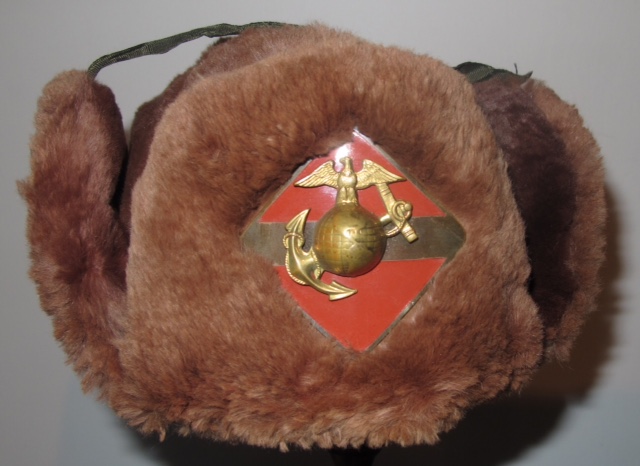
Winter fur hat with B Company red diamond. Photo courtesy of the Michael Manifor collection.
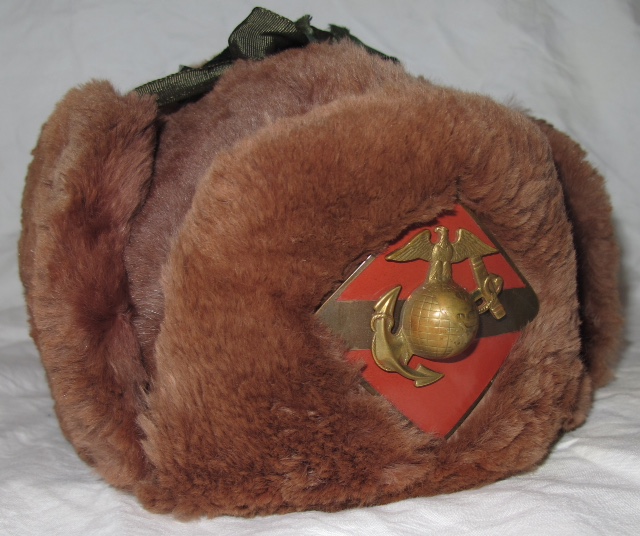
Another view of the winter fur cap. While an authentic enamelled diamond is a very rare piece of militaria, the fur hat the diamond is associated with, is vastly rarer as few of these survived to return to the states. Chester Biggs who got his fur hat back after World War II remembered giving his to his younger brother to wear during the winter months walking to school. After a year or so the hat, Biggs noted, wore out and was thrown away. Photo courtesy of the Mike Manifor Collection.
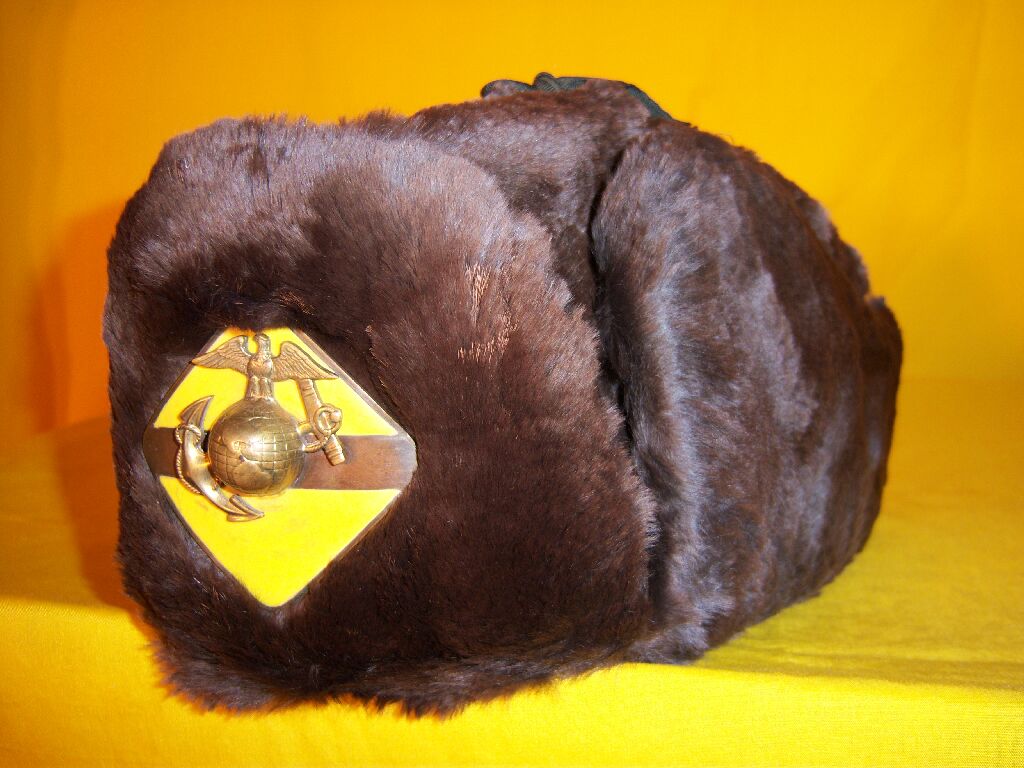
Winter Hat with the Mounted Detachment's Diamond. Courtesy of the MSgt Dan Whitton Collection
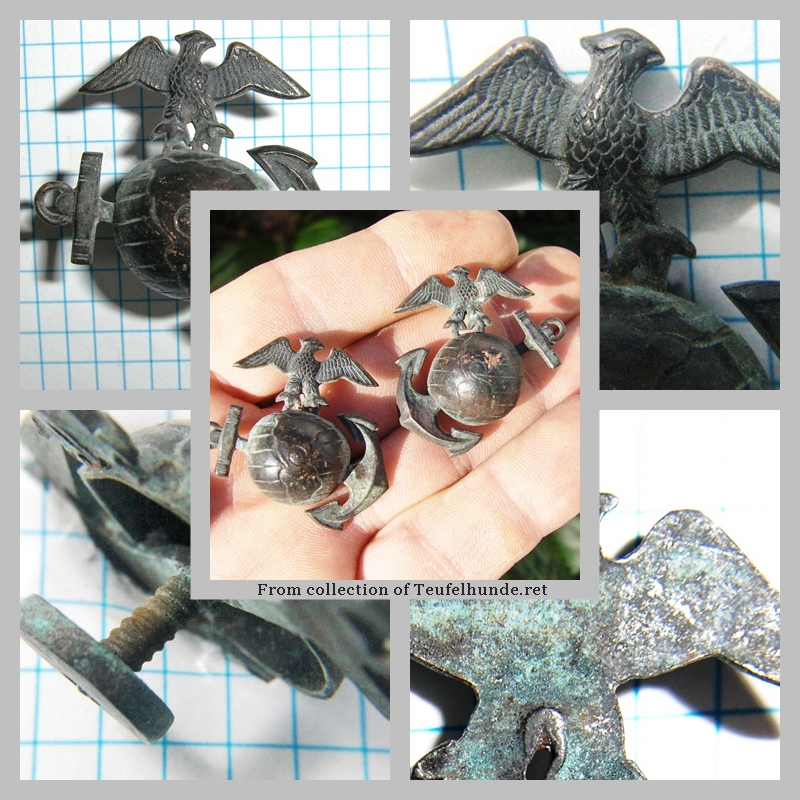
This Eagle, Globe and Anchor set of collar emblems was worn by Capt William Hill. What makes them unique is they were produced by a Chinese Jeweler. Photo courtsey of a friend
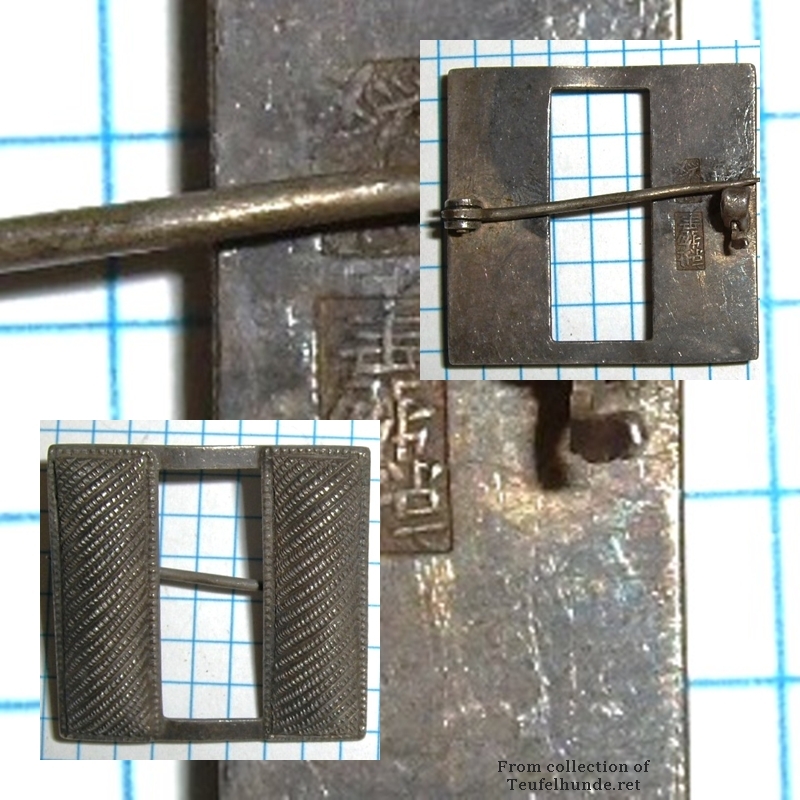
Chinese made Captains bars worn by Capt William Hill. Again photo courtsey of a friend
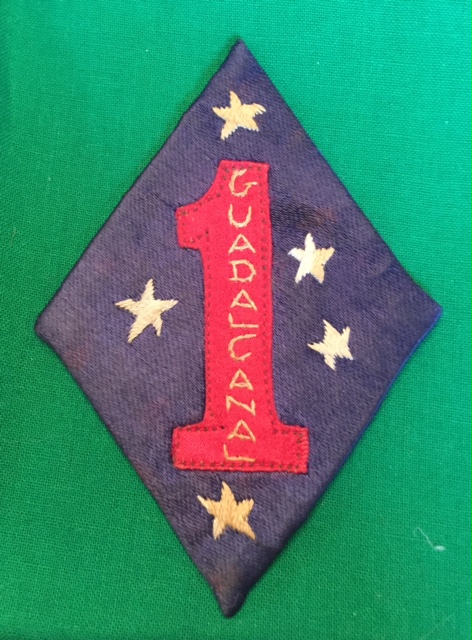
Chinese made 1st Division silk SSI. Post War.
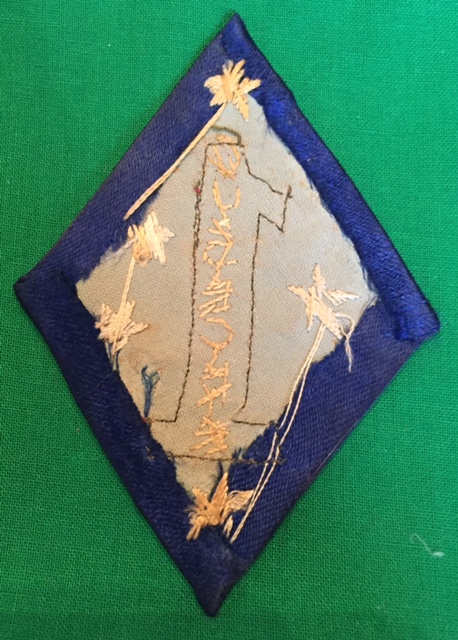
Reverse of the Chinese made 1st Division SSI
Medals
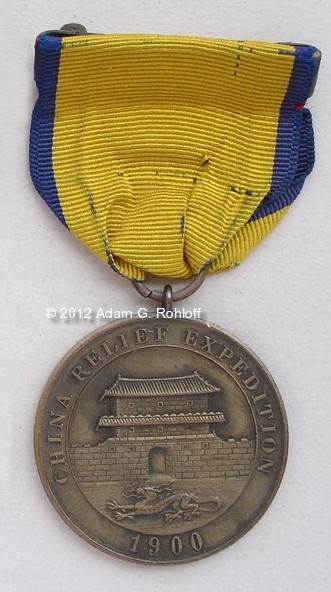
China Relief Expedition Medal
The China Relief Expedition Medal was awarded to Marine and Navy personnel who were a part of the China Relief Expedition, May 1900-May 1901. The Army had their own version of this medal, known as the Army Campaign Medal (Medal copied here with permission from the Adam Rohloff Collection)
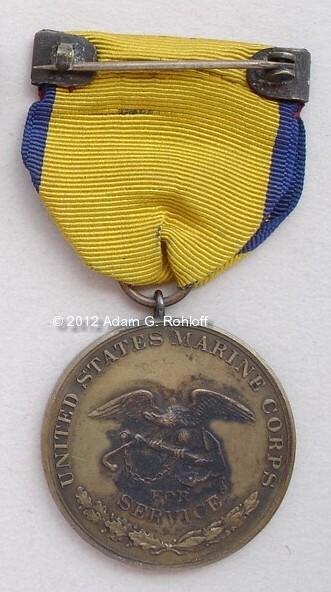
Reverse of the China Relief Medal
(Medal posted here with the permission of the Adam Rohloff Collection)
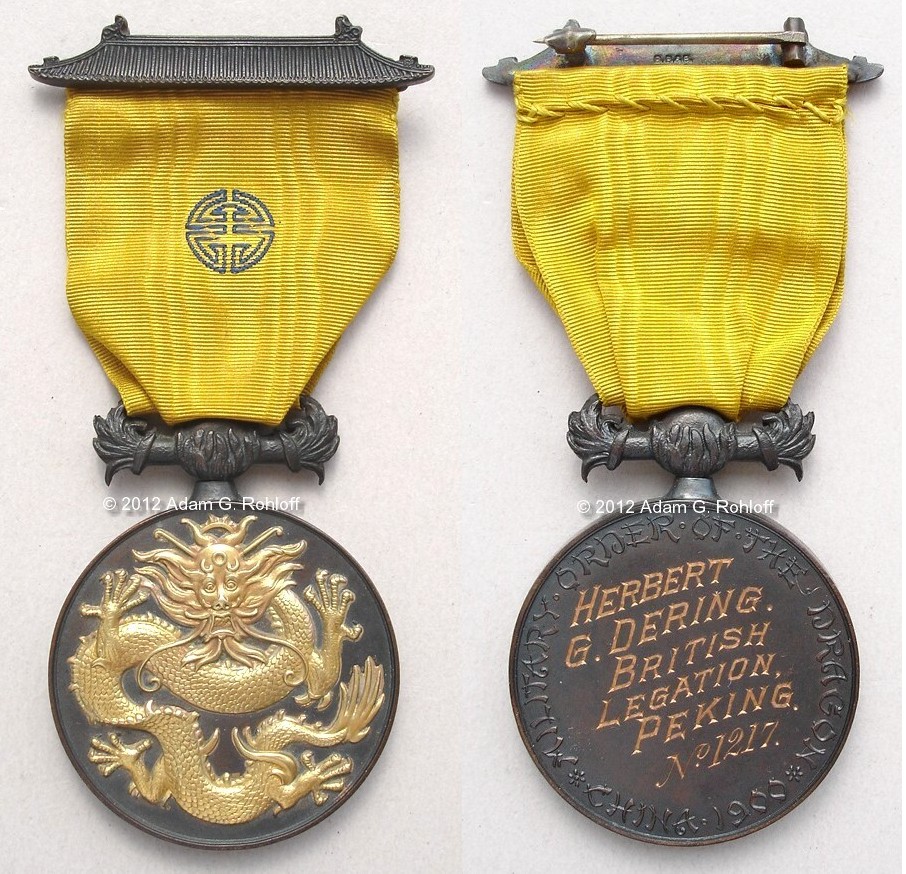
Military Order of the Dragon
This medal was created for officers of the International Relief Force that took part in the fighting in Northern China 1900-1901. As the campaign against the Boxers was winding down a group of officers formed a society to record and conserve the memory of the China Campaign. Medal copied with permission from the Adam Rohloff Collection.
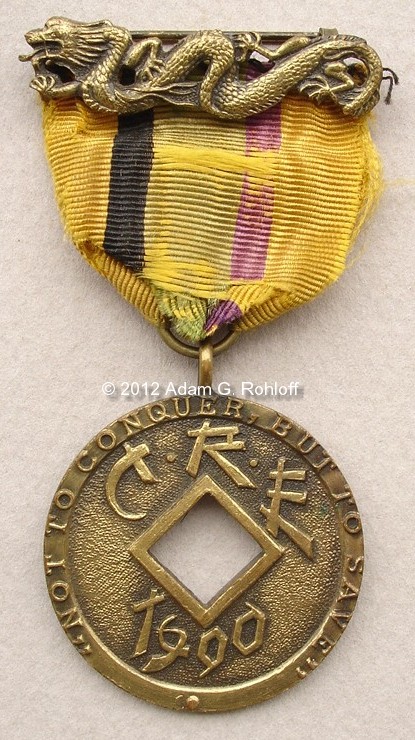
The Imperial Order of the Dragon. As the Military Order of the Dragon medal was for officers, this medal was given to enlisted men. From the Micahel O'Shea Collection. Photo courtsey of Adam Rohloff.
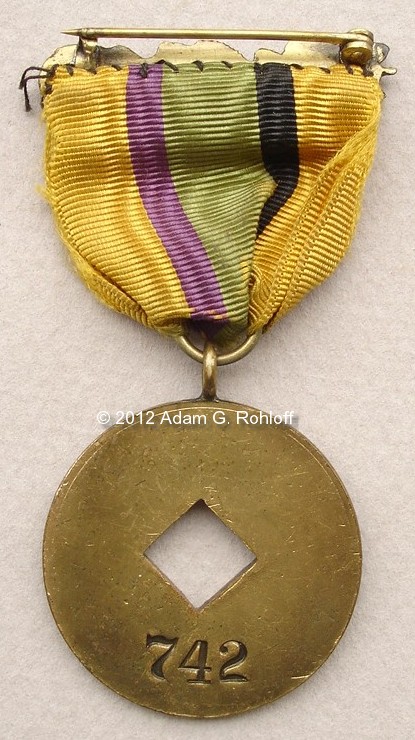
Reverse side of the Imperial Order of the Dragon. From the Michael O'Shea Collection, Photo courtsey of Adam Rohloff.
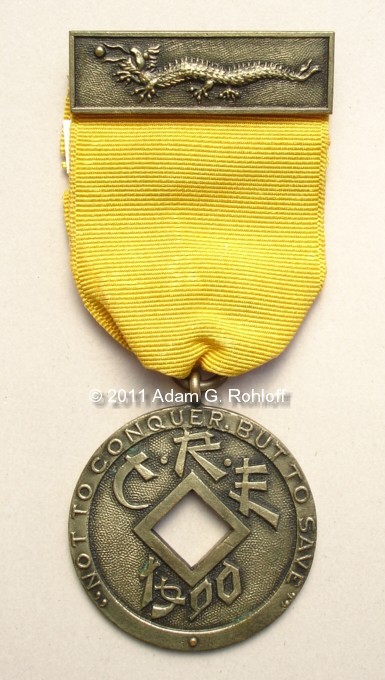
Another variation of the Imperial Order of the Dragon. From the Michael O'Shea Collection. Photo courtsey of Adam Rohloff..
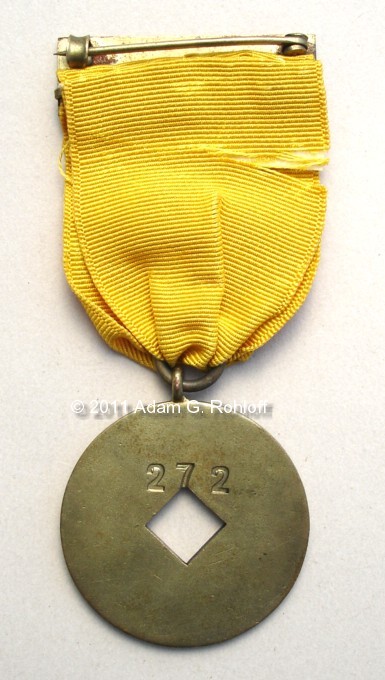
Reverse of the Imperial Order of the Dragon. From the Michael O'Shea Collection. Photo Courtsey of Adam Rohloff.
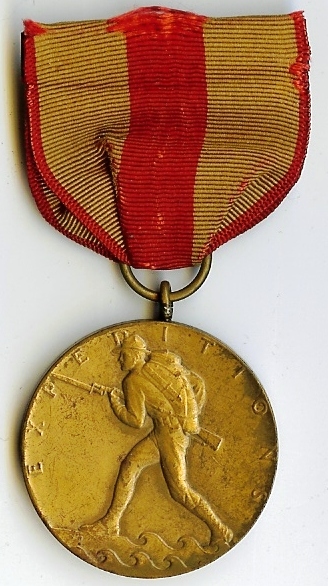
Marine Expeditionary Medal
Awarded to Marine Corps personnel who landed on foreign soil and engaged in operations against armed opposition or for special recognition, if no other award was authorized. Although first authorized as a ribbon in 1919, and as a medal in 1921, the medal was finally issued in 1929. China Marines could qualify for this medal retroactively for operations in China as early as 1894.
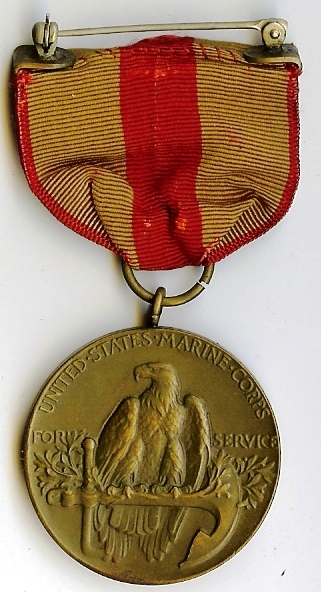
Reverse of the Expeditionary Medal
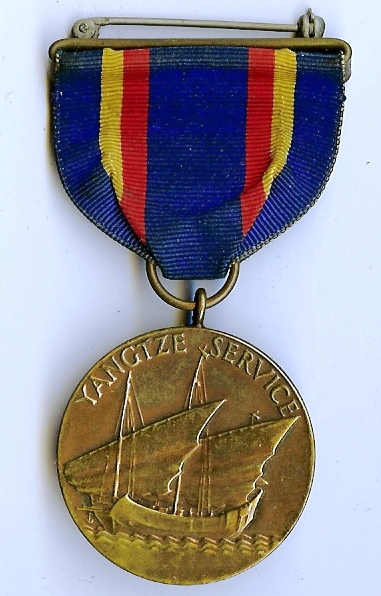
Yangtze Service Medal
This medal was awarded for service along the Yangtze River Valley from 3 September 1926 through 31 December 1932. This is a common medal awarded to Marines of the Asiatic Fleet as well as the first few drafts of the 4th Marines in Shanghai.
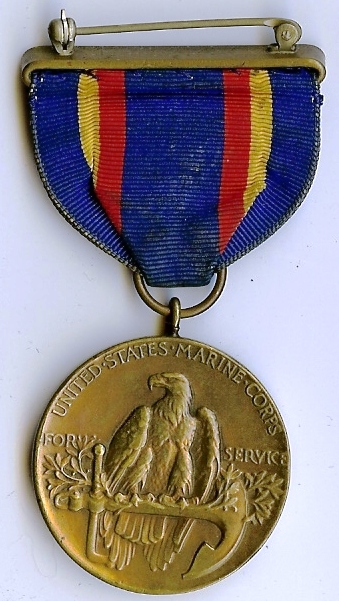
Reverse of the Yangtze medal

China Service Medal
This medal was awarded initially for service in China from July 1937 to September 1939. Since it was authorized during WWII, many Marines who were eligible to wear it did not apply for it, being unaware of its existence. It was later awarded for service in China following WWII through 1957. This example is one of the ealry US Mint strikes and would have been intended for a pre-War Marine.

Reverse of the China Service Medal
These medals, like the others above, were indivdually numbered on the bottom rim. The numbers would than be recorded into a Marines service record when awarded. This example is numbered 1333. These early strikes are considered scarce.
Shooting Badges
Although not a China specific award, the badges below were awarded for shooting at the Marksman, Sharpshooter and Expert Rifleman level. Instituted around 1907 they were awarded in three classes as noted above. From examples seen in various private collections these badges were engraved on the back with the date awarded and the shooters name. This official engraving seems to have stopped just prior to 1916. Although some Marines did have their names, scores and dates awarded privately engraved post-1915. Not only did earning these awards provide an additional increase in ones pay but it also provided a great source of pride to the awardee. Through research I have learned that several photos in my collection were taken just after a Marine was awarded his marksmanship badge.

Expert Rifleman Badges. The badge on the far left was awarded to a Marine officer serving at the Peking Legation in 1913. Also note the type of rifle used for these badges changed over time.
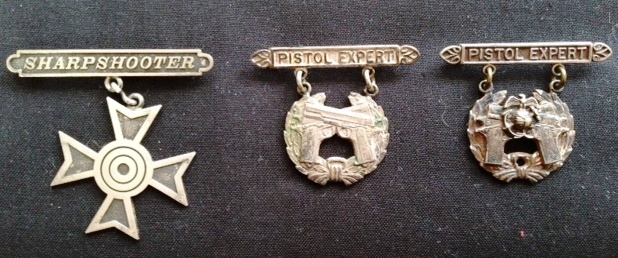
A Sharpshooter badge and several pistol expert badges. This Sharpshooter badge was awarded to a Pvt in the Legation Guard in 1913. Note the pistol badge on the far right has been customized with a EGA. Although not offically sanctioned, EGAs were often added to the badge by the Marine
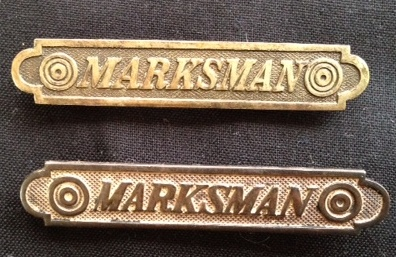
Two examples of the Marksman badge
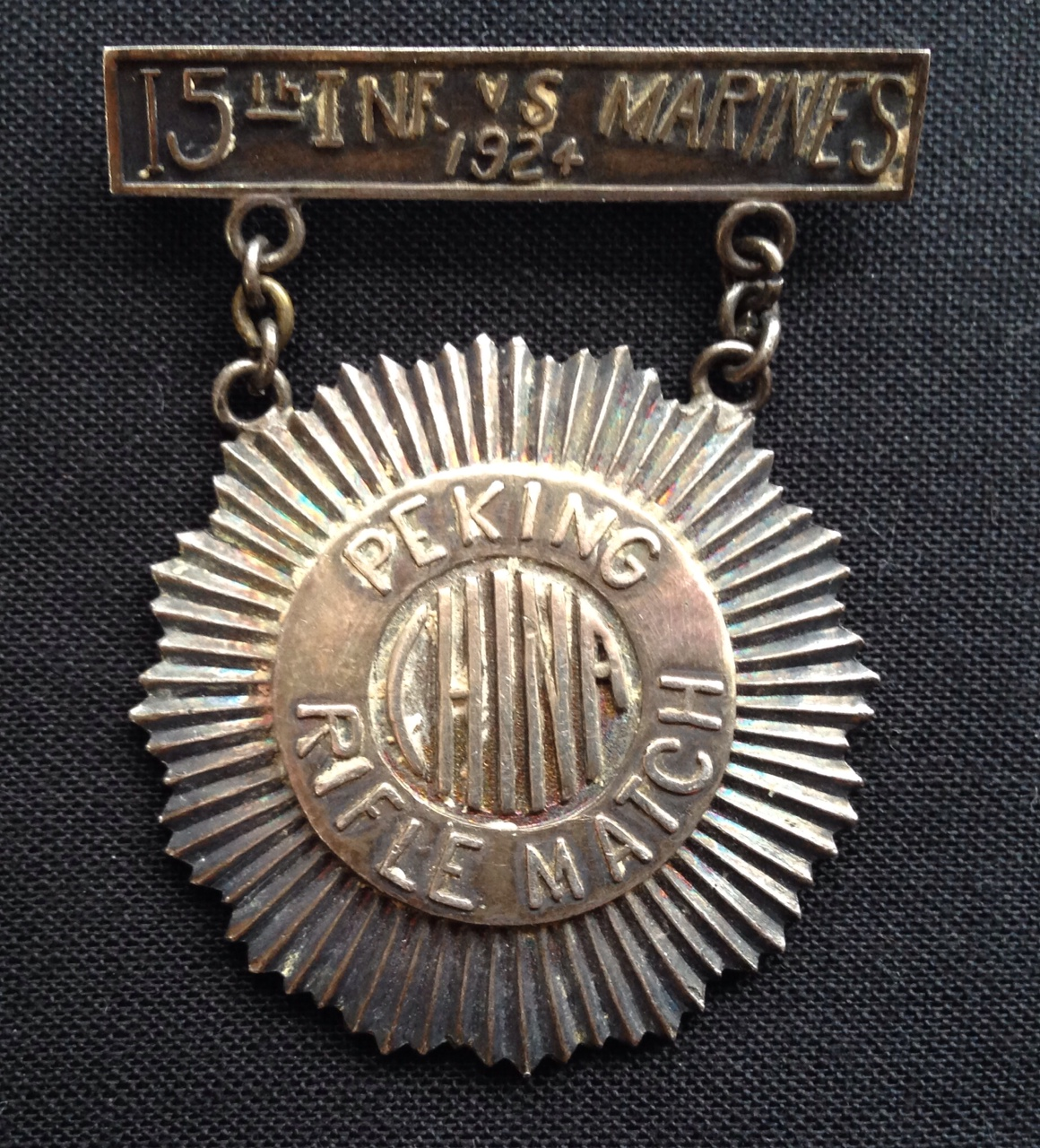
A scarce Chinese made badge commemorating the 1924 North China Intraservice Rifle Competetion bewteen the Marine Legation Guard and the 15th U.S. Infantry
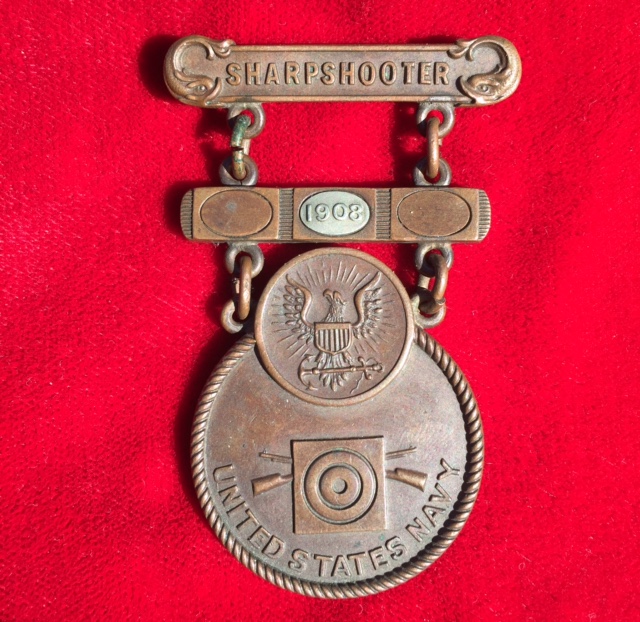
Early Navy Sharpshooters badge awarded to a Marine Drummer assigned to the gunboat USS Wilmington.
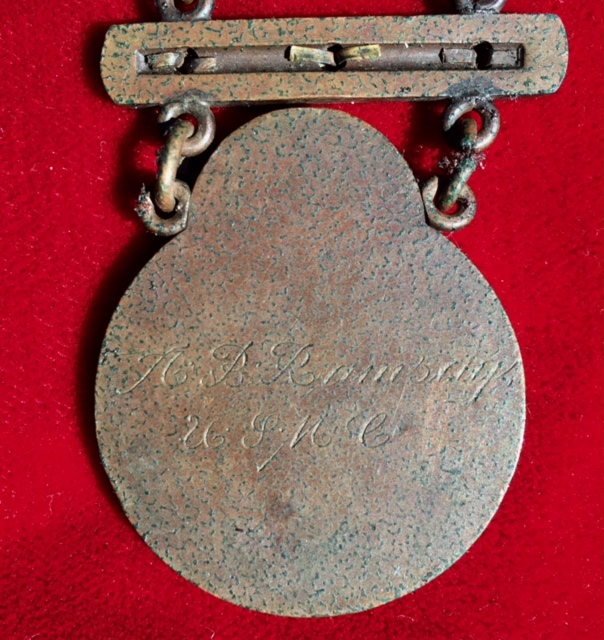
Showing the reverse of the badge above, to highlight the engraving.
Spoof Medals
The Soochow Creek Medal. Originally designed by a member of the 4th Marines following the 1932 Battle of Shanghai, this medal was an unofficial award Marines could purchase to commemorate their “suffering” during the conflict. The medal, meant in humor, shows a “Honey” cart and its driver on the obverse. The term “honey cart” was applied to a method of Chinese urban waste disposal and the colors of the ribbon may well have hinted at the waste the driver was carrying. Other examples show a second type of ribbon in red, white and Blue, supposedly for Navy personnel who wanted their own medal.The medal was available with either a coppery-bronze or gold finish. These "medals" were never to be worn on the uniform.
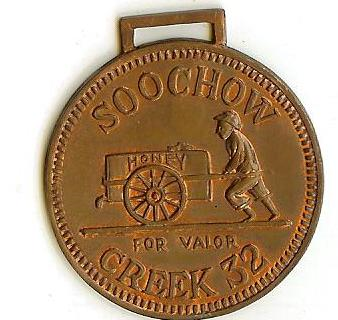
A 1932 Type I Soochow. Planchet only
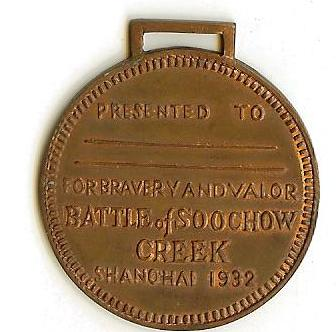
Reverse of the 1932 Soochow. Note the two raised lines bracket a space where a Marines name could be engraved.
The Soochow medal was “reissued” in 1937 during the second Battle of Shanghai. Again the medal was available in both gold and bronze finishes. Not every example was engraved on the reserve with the owner’s name. This example is considered a 1937 Type III medal and is engraved to a Marine who served with the 4h Marines.
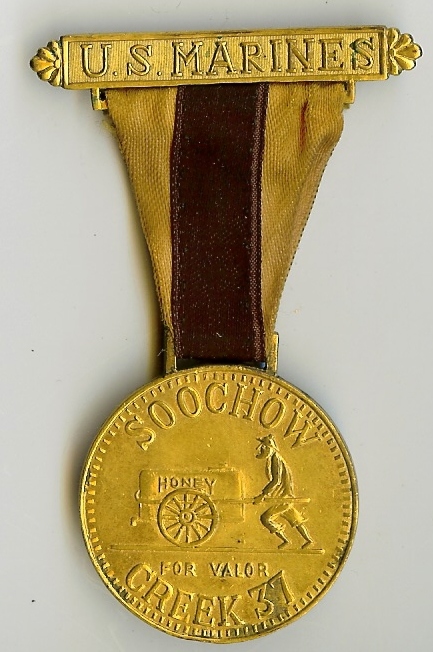
The ribbon of the gold finish medal is two pieces, a gold cloth base with a seperate brown cloth stripe attached.
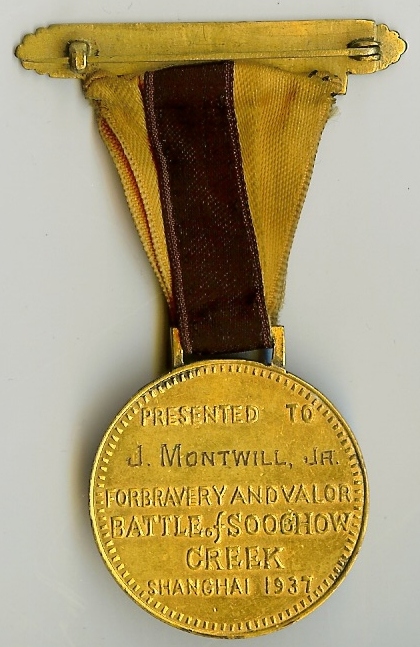
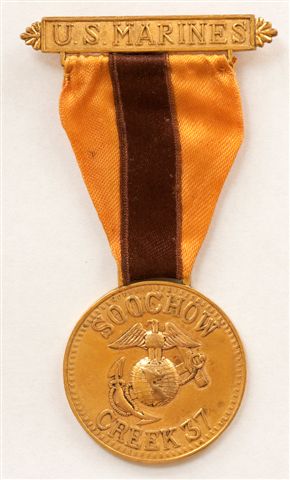
This is an example of a Type V Soochow Medal bearing the Marine Eagle, Globe and Anchor on the obverse. The reverse shows the engraved name to another 4th Marine. (Courtsey the Joe Brooks Collection)
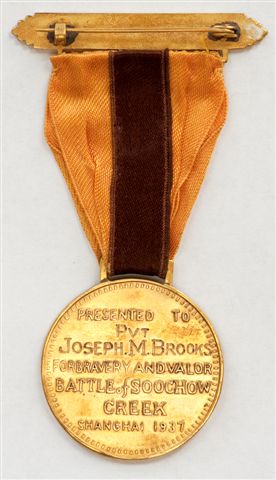
Reverse of the Type V Soochow Medal (Courtsey the Joe Brooks Collection)
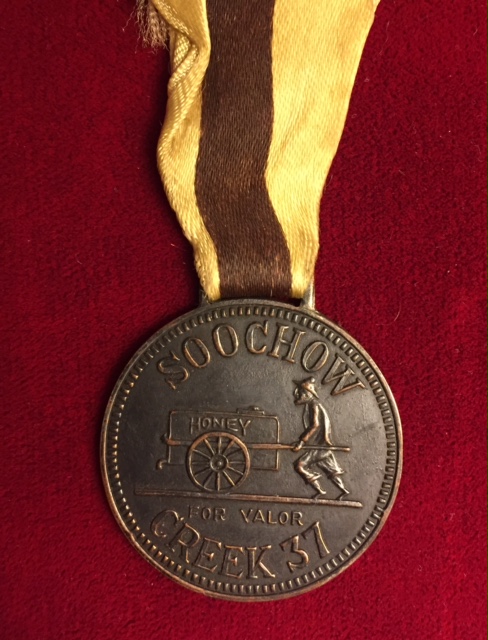
A bronze finish 1937 Soochow Creek Medal. The brooch is missing from this example. Also note, unlike the gold finish, the ribbon on the bronze medal is of single piece cloth construction.
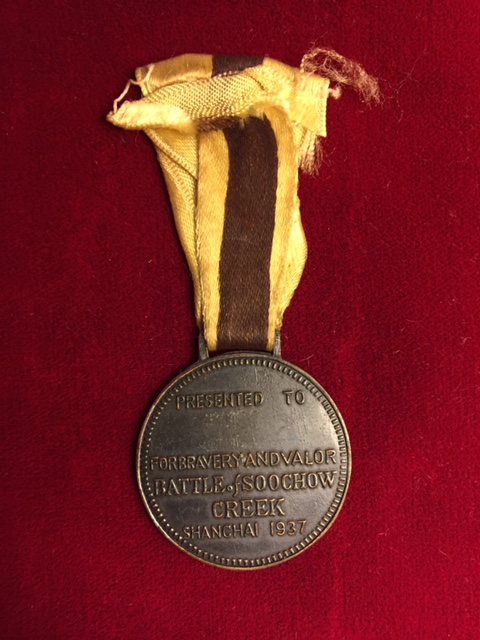
Reverse side of the 1937 bronze finish Soochow Creek Medal. This medal is unengraved..
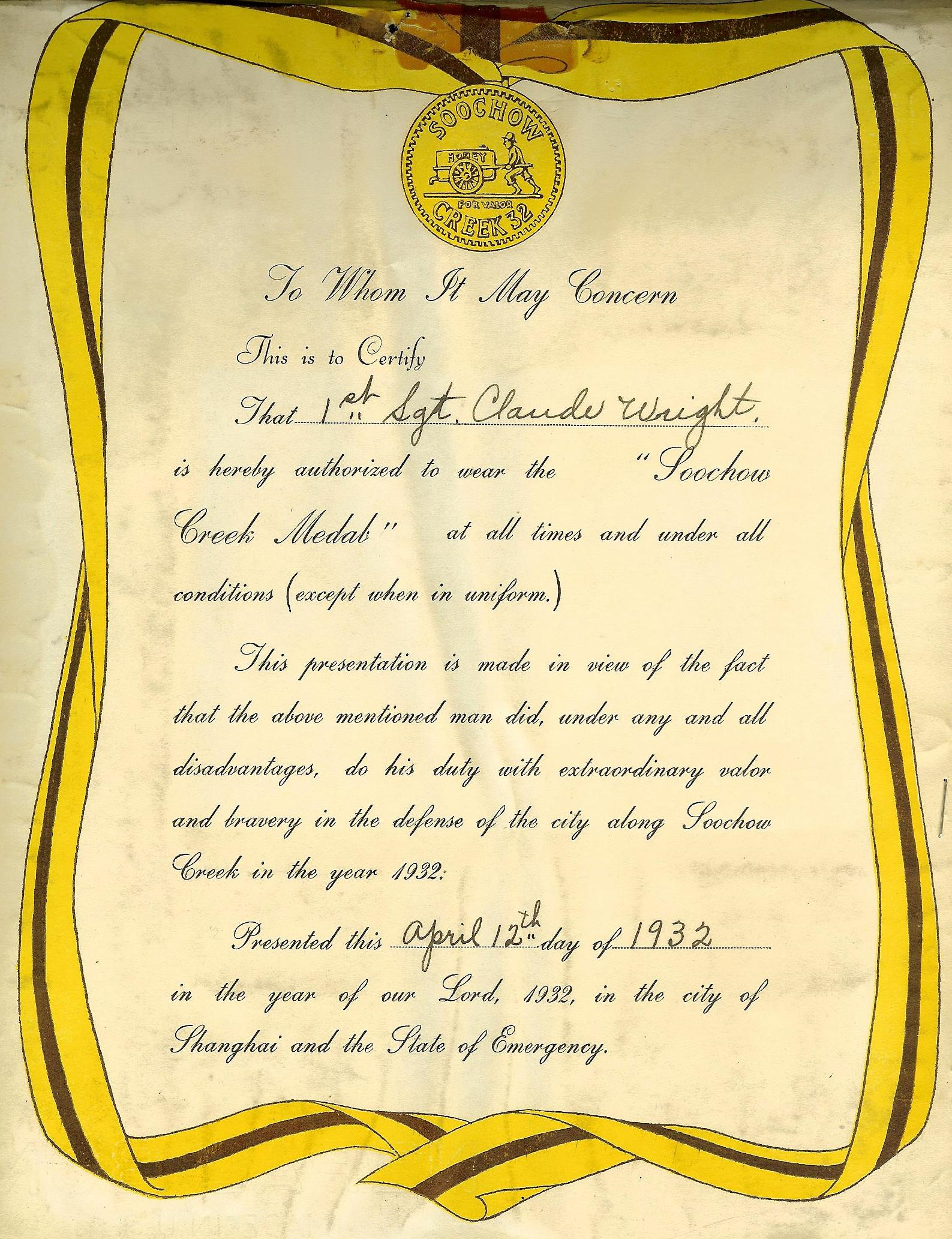
Both the 1932 and 1937 versions of this medal were accompanied by a paper certificate. These certificates are far rarer than the medals themselves, as few certificates have survived. At this time I believe the certificates were printed and sold by Yuan Jing Tai's Hardware and Glass Store in Shanghai.
The Hangchow House Boat Expedition. During the 1930's several 4th Marine Chaplains organized house boat trips beginning in Shanghai and traveling along the Soochow, and various canals to the coastal city of Hangchow. House boating along these waterways was a very popular tourist activity during these years. To commemorate at least one of the Chaplain sponsored events, participants developed a spoof medal very similar to the Soochow Creek medal, and probably made by the same manufacturer. This is a very scarce medal.
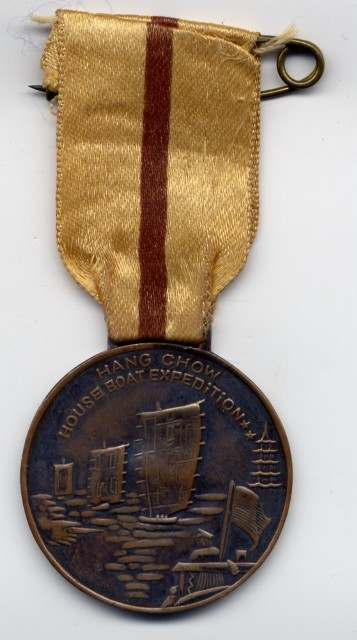
The Hangchow Houseboat Expedition Medal
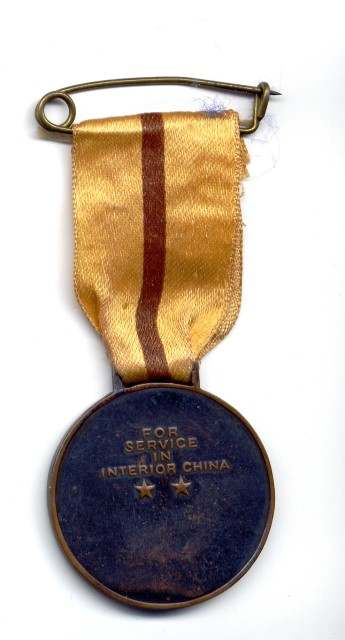
Reverse
Asiatic Fleet Medal. Although not a spoof medal this Asiatic Fleet Medal made by "The Special Dragon Works" Company, located at 126-27 Minghong Road, Shanghai has been associated primarily with organized Asiatic Fleet sporting events. It appears to have been created in the early 1920's. This example is done is bronze.
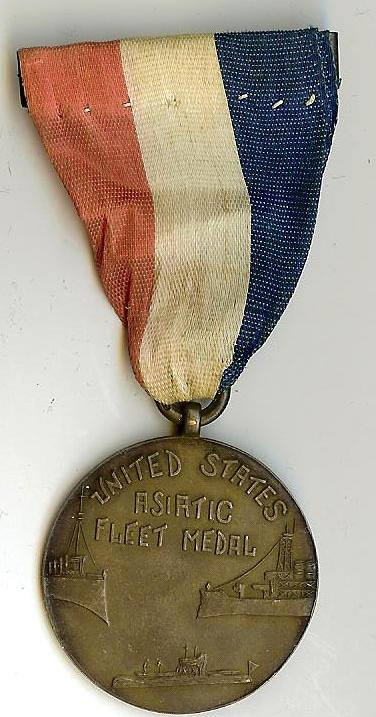
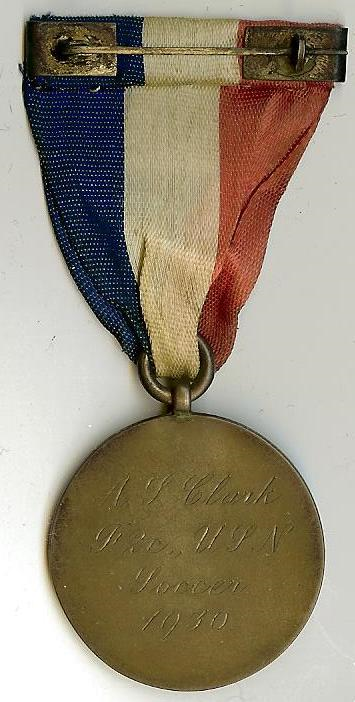
Blades
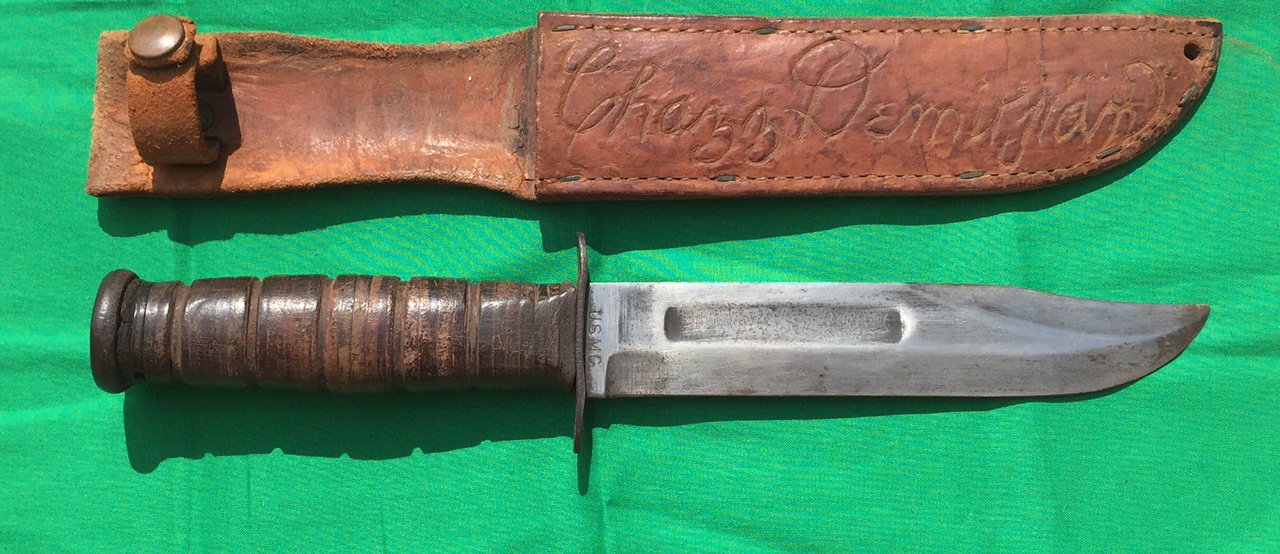
Ka-Bar Knife carried by Cpl Charles DeMirjian thoughout his time in the Marines during WWII. Although designed for use during the war, Marines continue to use the Ka-Bar today. DeMirjian personalized the sheath, as was done by many Marines during that time.